[[CCCats]] ⦿ [[Crooks]] ⦿ [[Gravents]] ⦿ [[Nautipods]]
CCCat Traits
Fur/Coat
Ears
Eyes
Teeth
Tongue
Crowns
Tail
Body
Misc.
Required
- Pattern - [The CCCat must have one pattern, which generally consists of a repetitive pattern. Gradients do not count for patterns]
Common
- Mane - [Longer fur somewhere on neck]
- Hair - [Hair-like fur on head or neck (to mid-section or higher)]
- Body Fur - [Short fur with larger mid-range length fur elsewhere on body]
- Facial Fur - [Fur that resemble facial hair on humans]
- Ridge - [Fur traveling down spine]
- Color Blindness - [Pastels, Naturals, or Combo. They see magic differently, in bright colors. Either in a limited array or more colors]
- Omen Sight - [Black, White, or Grayscale colors on the CCCat caused from being able to see luck magic]
- Furred - [Can be curly, straight, wavy, etc. All hair textures available]
- Frankenstein Markings - [Two different sets of markings that stop abruptly against each other, like chimerism]
- Piebald Markings - [Solid color splotching above all patterns. Considered a blurry memory
Common Fur Visual Examples

Uncommon
- Sphinx Fur - [Hairless, or nearly hairless. This also includes peach fuzz, or very very short hair]
- Royal Fur - [Any long strands of fur that are noticeably longer than the rest of the design's fur. This includes ribbons, ponchos, long ankle fur, etc. All pieces must still resemble and act like fur/hair. This trait can be added to a CCCat using the Silky Brush Trait Item]
- Particle Markings - [Particles that trail from a specific marking, similar to particle crowns. These can be shaped, but must be small particles]
- Frankenstein Fur - [Patches of normal fur and furless patches separated by an abrupt change in length, including bald patches on the face]
- Cheesepuff - [Excessive full body fur]
Uncommon Fur Visual Examples
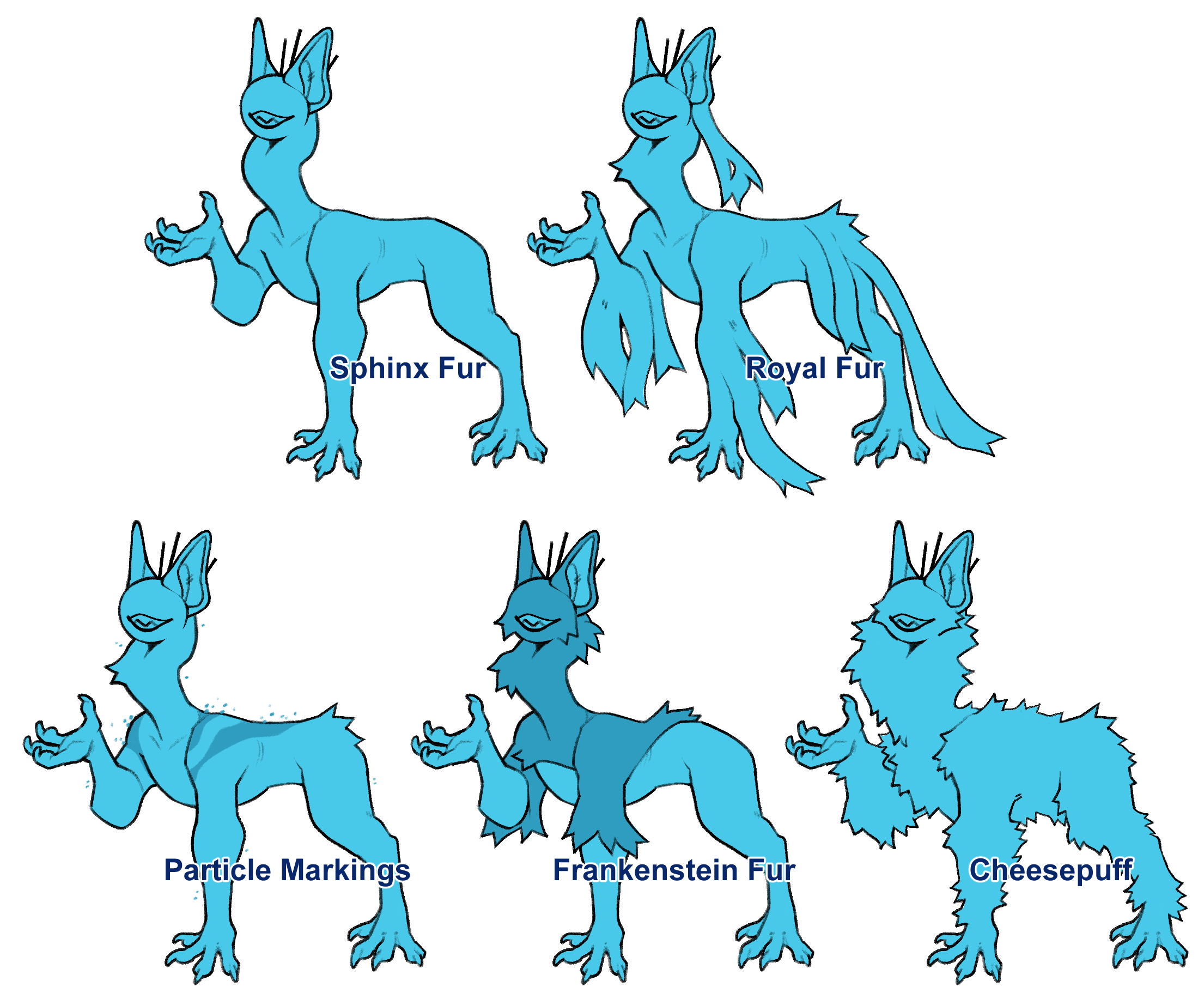
Rare
- Glowing Markings - [A marking type that glows -- Effects 3 colors on the body. Glow must be the same color as the color that is glowing. This can also affect the crowns]
- Metallic Markings - [Markings that reflect light like metal -- They do not change color. Effects 3 colors on the body. This can also affect the crowns, though they should not heavily resemble objects]
- Opalescent Markings - [Markings shimmer different colors in light -- Effects 3 colors on the body. This can also affect the crowns, though they should not heavily resemble objects]
- Sparkling Markings - [A marking type that sparkles -- Effects 3 colors on the body. This can also affect the crowns, and allows particle crown/markings to be sparkles as well if the trait is posessed]
Rare Fur Visual Examples

Myth
- Color-Changing Markings - [Markings that change color because of mood, willpower, or otherwise. -- Effects 3 colors on the body. Can change from one color to another color for a total of two]
- Color-Changing Coat - [Base coat that changes color because of mood, willpower, or otherwise. Only applies to the base color]
- Glowing Coat - [A glowing effect that affects all colors on the body. This trait can include the teeth and crowns]
- Metallic Coat - [A metallic sheen that affects all colors on the body. This trait can include the teeth and crowns]
- Opalescent Coat - [An opalescent sheen that affects all colors on the body. This trait can include the teeth and crowns]
- Sparkling Coat - [Sparkles that affect all colors on the body. This trait can include the teeth and crowns]
Myth Fur Visual Examples
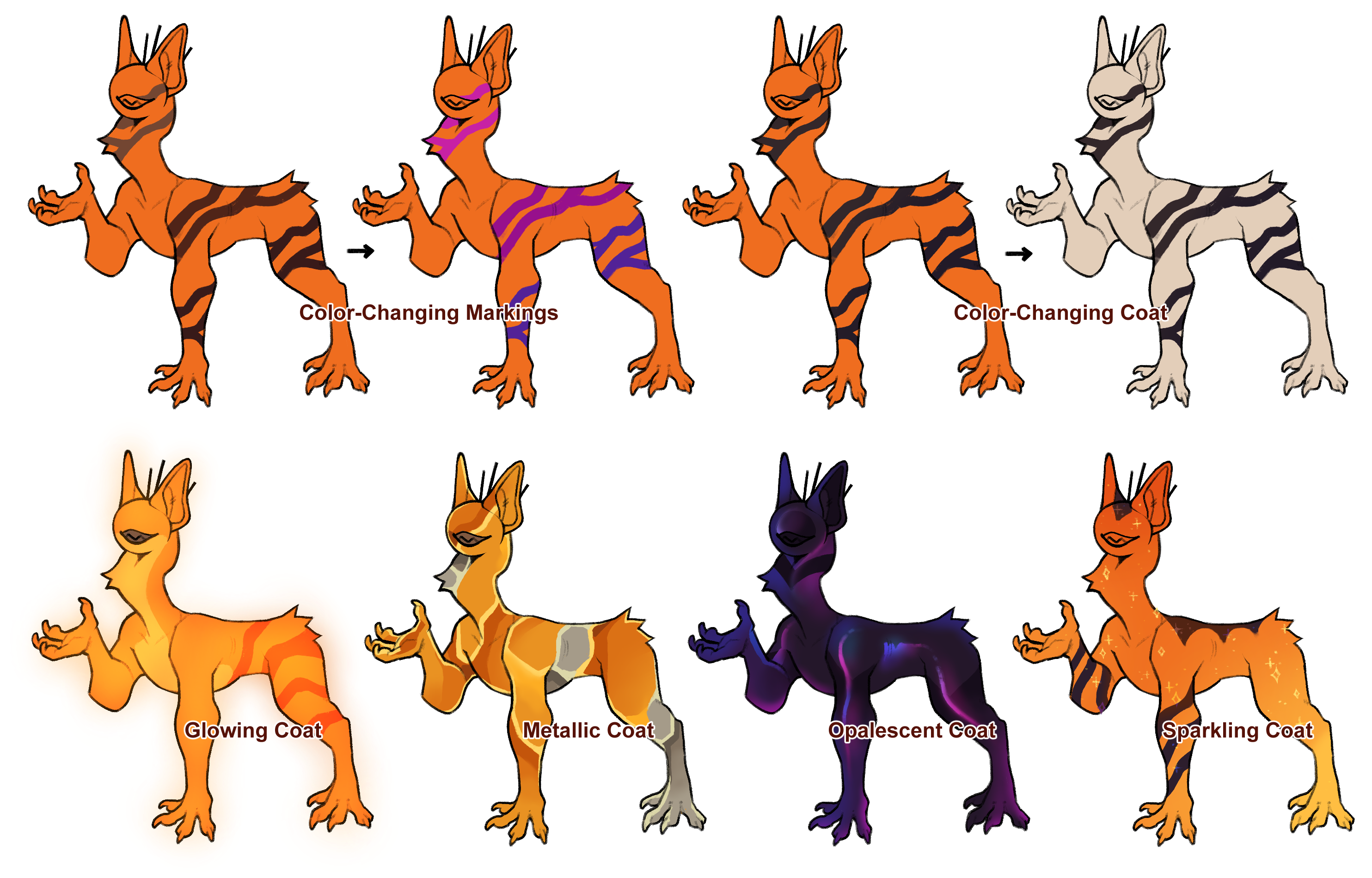
Touched
- Second Set of Colors - [Coat that can completely change all of its colors -- NOT markings. This covers one extra set of colors, for a total of two. Tongue and Eye colors cannot change]
- Shifting Markings - [Coat that can change its markings/patterns -- NOT colors. Examples are eyes that blink, swirls that spin, and generally change appearance. It must remain visually similar]
- Rainbow Shift - [A set of markings can shift between all colors of the rainbow]
Touched Fur Visual Examples
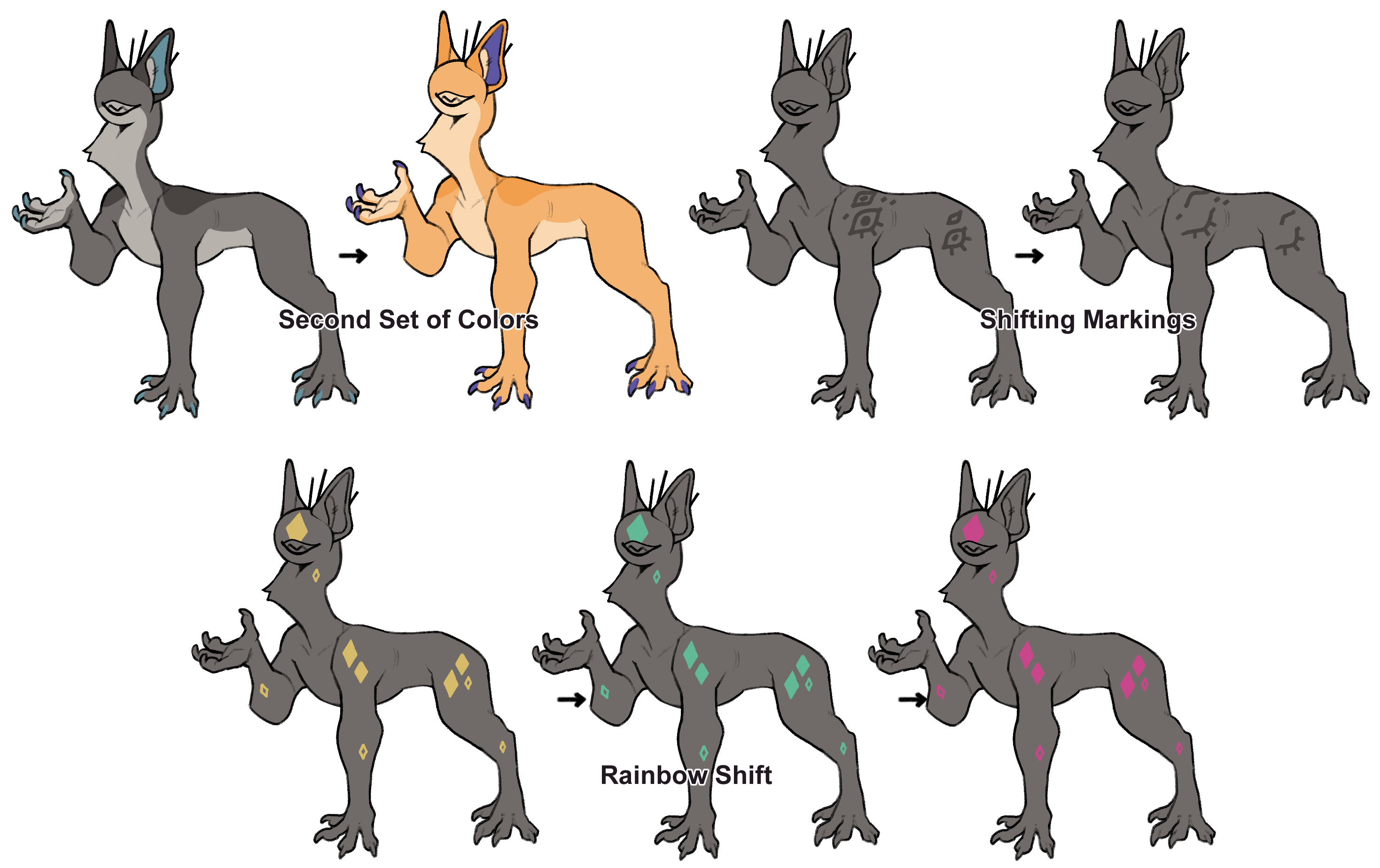
Unseen Affliction
- -
Lore-breaking
- Patternless - [The CCCat has no pattern. Gradients do not count as a pattern]
Required
- 2 Ears Minimum - [Loss due to injury is not traited but must still show evidence an ear was once present]
Common
- Fluffy Ears
- Furless Ears
- Bent Ears
- Oddly Shaped Ears - [Ears may have odd shapes, holes, and different lengths]
- Mismatched Ears - [Ears may be asymmetrical]
Common Ear Visual Examples

Uncommon
- Droopy Ears - [Ears that are droopy or floppy at the base]
- Multiple Ears (3-4) - [Ears can be placed asymmetrically as long as they are placed in general ear position
Uncommon Ear Visual Examples
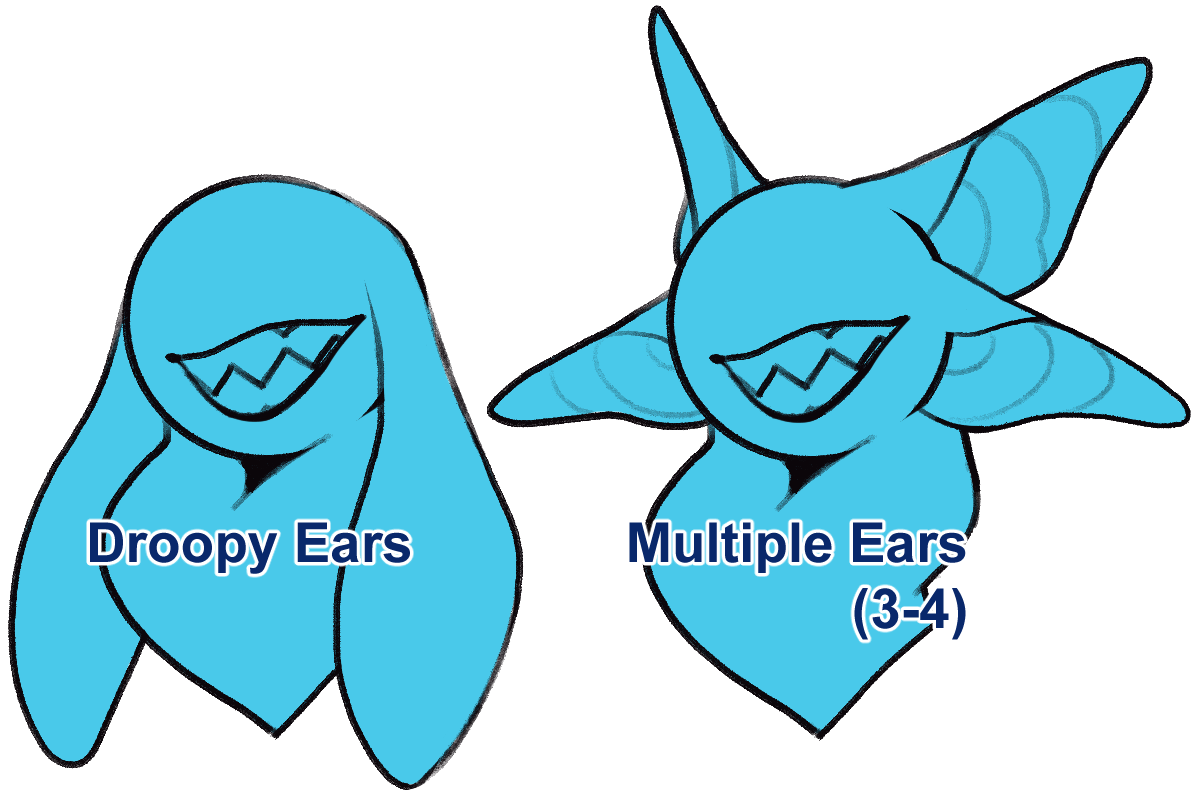
Rare
- Multiple Ears (5-6) - [Ears can be placed asymmetrically as long as they are placed in general ear position]
- Linked Ears - [Ears that are merged together above the base]
Rare Ear Visual Examples
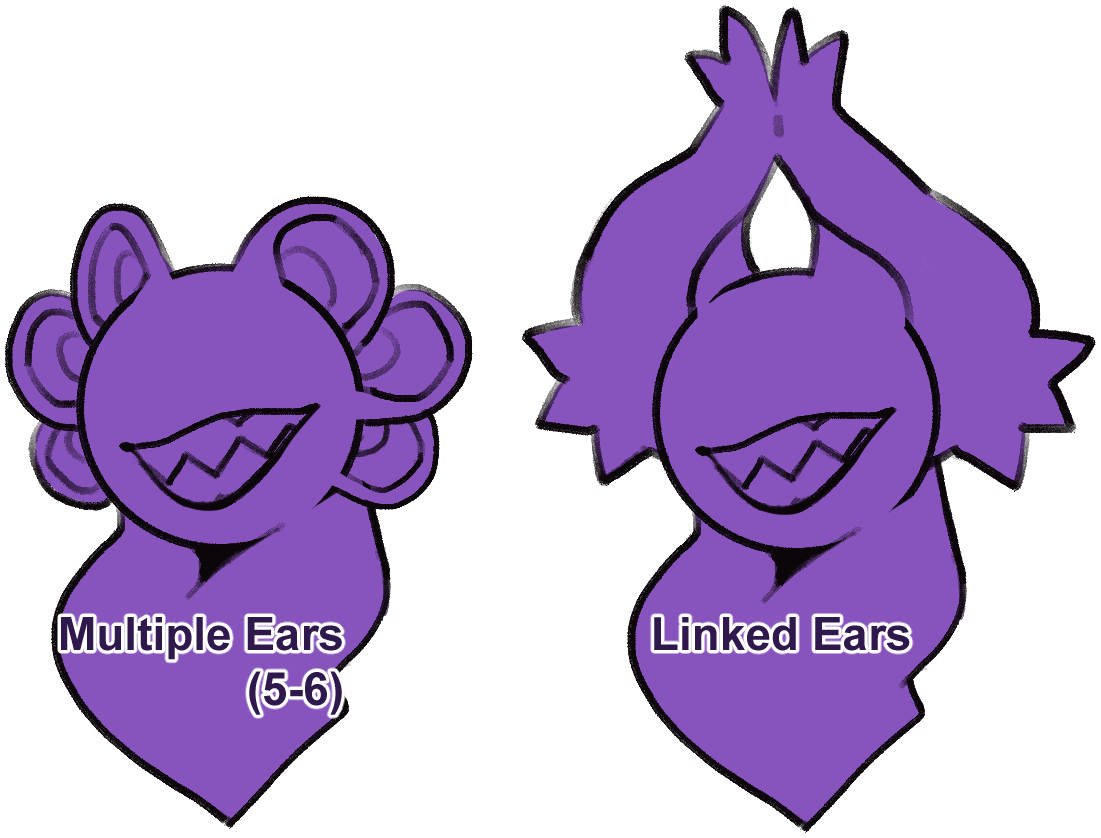
Myth
- Multiple Ears (7-10) - [Ears can be placed asymmetrically as long as they are placed in general ear position]
- Overgrown (Ears) - [Ears that are very clearly larger than are proportional to the character]
- Wing Ears - [Grants levitation magic. Can be bat or feathered, or a mix of the two, and can articulate like wings]
Myth Ear Visual Examples
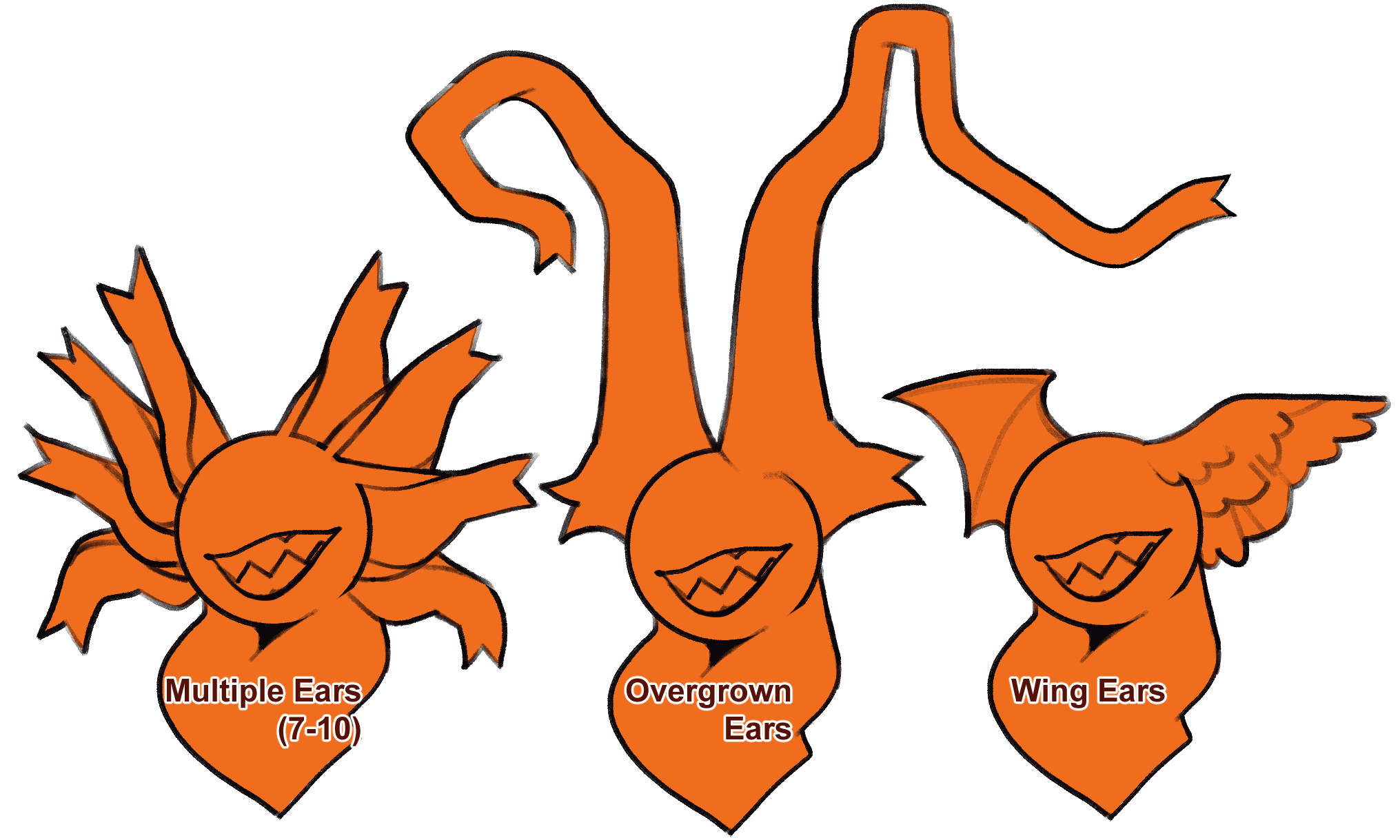
TOuched
- -
Unseen Affliction
- -
Lore-breaking
A CCCat’s eye must be above 43% saturation and value to be considered a living eye. Please provide a flat and unshaded eye reference when submitting a MYO or Redesign (MYO and Redesign Guide)
Required
- 1 Eye Orb Minimum - [A solid eye that contain’s the CCCat’s essence]
Common
- Saturated/Living Eye - [Eye is bright and saturated with a pupil of the same but slightly darker color. This color range implies a living CCCat. Standard Eye cannot dip below 43%
- Saturation and Value on an HSV/B scale. Please submit a flat and unshaded eye reference when submitting a MYO or Redesign]
- Slit Pupil - [Pupils are able to dilate but must retain their base shape]
- Round Pupil - [Pupils are able to dilate but must retain their base shape]
Common Eye Visual Examples

Uncommon
- Goat Eye - [Any horizontal, rectangular or goat shaped pupil]
- Dual-Colored Eye - [An eye where the pupil is a different hue than the base, as well as monochrome eyes where the pupil is lighter]
- Split Pupil - [The pupil appears as though it is incompletely split in two. This can be applied to standard round and slit pupils]
- Central Colored Eye - [The pupil has an extra ring of color around it. This can be applied to standard round and slit pupils. The base color and pupil color must still be the same hue]
- Sectoral Eye - [The eye color is split. The pupil remains intact, but the sclera colors divide into two. This split can be down the middle, or more organically split. The pupil must reflect only one of the two colors]
Uncommon Eye Visual Examples

Rare
- Patterned Eye - [An eye that can have any pattern, as long as a 'pupil' pattern is visible. Any living color can be used]
- Glowing Eye - [Entire eye or parts of it glow. It must glow the same color as the eye]
- Metallic Eye - [Eye that has an overall metallic sheen]
- Opalescent Eye - [Eye has an overall opal sheen]
- Sparkling Eye - [Eye that sparkles. Sparkles should not fall from the eye]
- Multi-Form Eye - [The eye changes between each new form of the CCCat. Any new eye traits added must be counted additionally, but the eye can switch color and pattern between forms using this trait. Only applies if multiple forms are present on a design]
Rare Eye Visual Examples

Myth
- Pattern Shifting Eye (1-5) - [The pattern of the eye shifts. Patterns should have a similar base to avoid appearing as a completely different eye. This creates up to five patterns total]
Myth Eye Visual Examples
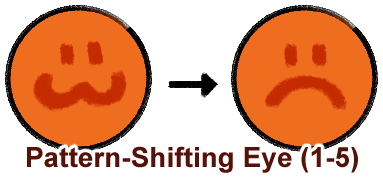
Touched
- Pattern-Shifting Eye (6-10) - [The pattern of the eye shifts. Patterns should have a similar base to avoid appearing as a completely different eye. This creates up to ten patterns total]
- Cursed Eye - [An eye that inflicts a curse or pain on others or the owner. May have odd shapes or anomalies]
- Cracked Eye - [An eye that is cracked, allowing essence to escape. For CCCats this is depicted as a dripping substance from the crack]
- Elemental Eye - [An eye with features or made up of elemental substances]
- Dead Eye - [Implies reanimation of a CCCat, and is shown through black, white, greyscale, or dull colors in the eye. Any eye with a Saturation or Value below 43% will be considered dead]
- Pupil-Less Eye - [The eye is solid in color or lacks no discernable pupil shape]
- Multiple Eyes (2-3) - [A CCCat who has up to 2 additional eyes apart from their standard eye (3 total eyes). Up to 3 eyes can be affected by a shared eye trait but do not need to visually look the same between one another]
Touched Eye Visual Examples

Unseen Affliction
- Multiple Eyes (4-10) - [A CCCat who has up to 9 additional eyes apart from their standard eye (10 total eyes). Up to 3 eyes can be affected by a shared eye trait but do not need to visually look the same between one another. Each additional eye counts as a separate, unique eye and does not share traits between them]
- Object Eye - [A CCCat’s eye is replaced with an object that stands in place of and functions as the eye]
- Living Eye - [The essence in the eye forms into a living shape, such as a bird, fish, or other creature. It appears as though the creature is held within a glass orb]
- Shattered Eye - [The eye is completely shattered and fragmented, consisting of small pieces that maintain proximity to each other. Essence floats within the center. It may also manifest as merged to the tongue]
Unseen Eye Visual Examples

Lore-breaking
- Blind Eye - [An eye afflicted by the inability to see anything]
- Dead Eye (Old-Gen) - [Eye created with dead colors unintentionally or before rules were in place. The lore surrounding dead eyes can be used for these CCCats. Cannot be swapped for other traits. Please refer to the old-gen rules regarding this trait]
Required
- 1 Row of Teeth
- 1 Mouth
Common
- Diamond - [Teeth are diamond shaped]
- Dull - [Teeth are a duller, but still pointed shape]
- Movable Teeth - [CCCats can shift their teeth in minor ways to point them outward to a small degree! This can help them to protect or intake their eye]
- Colored Teeth - [Solid colored teeth can be any color]
Common Teeth Visual Examples
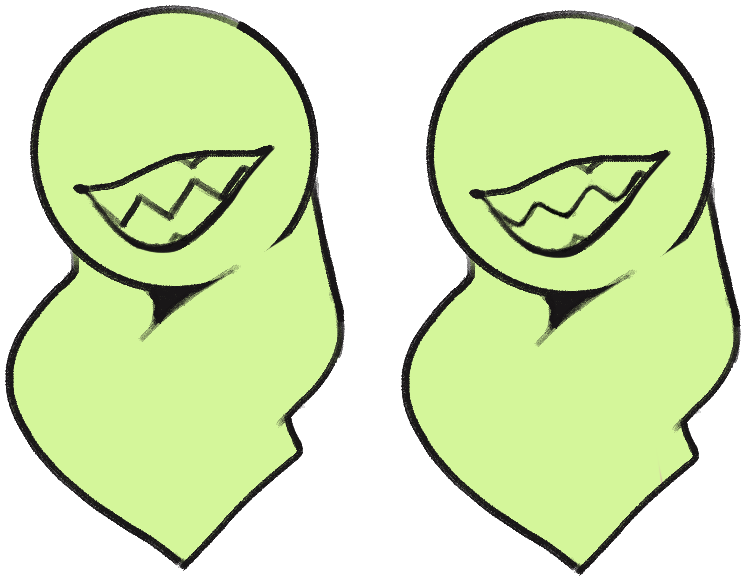
Uncommon
- Glowing Teeth - [Part or all of the teeth glow]
- Metallic Teeth - [Part or all of the teeth are metallic]
- Opalescent Teeth - [Part or all of the teeth are opalescent]
- Sparkling Teeth - [Part or all of the teeth sparkle]
- Underbite - [Lower jaw’s teeth overlap the upper jaw]
- Overbite - [Upper jaw’s teeth overlap the bottom jaw]
- Multi-Colored Teeth - [Teeth with more than one color]
- Messy Teeth - [Teeth that overlap, slant, or turn at an odd angle. Teeth should remain similar in size]
- Razor Teeth - [Thinner, sharp teeth]
- Gapped Teeth - [Teeth have gaps between them, areas of uneven space or the absence of teeth]
Uncommon Teeth Visual Examples

Rare
- Saber Teeth - [Two large upper-mouth teeth, externally visible, or fangs that do not extrude from the mouth]
- Tusks - [Two large lower-mouth teeth, externally visible]
- Tipsy-Turvy Teeth - [One tusk and one saber tooth on opposing sides]
- Snaggletooth - [One externally visible tooth, either tusk, saber, or fang]
Rare Teeth Visual Examples
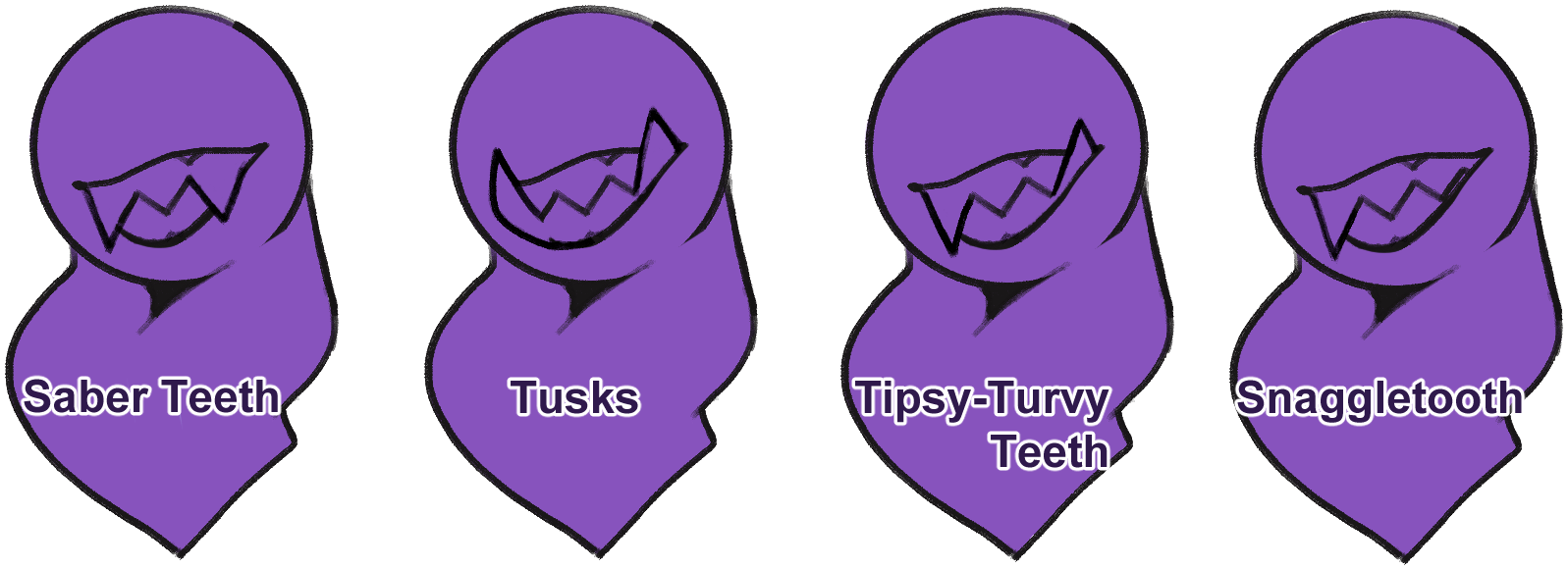
Myth
- Extra Rows of Teeth - [Extra rows of teeth, usually full rows behind the front row, though it can also be done externally so long as the teeth are visibly teeth. Usually up to 2 rows]
- Overgrown Teeth - [Teeth that are very clearly larger than are proportional to the character]
- Needle Teeth - [Long teeth that are so long that they cannot fully close. Interlocks like a venus fly trap]
Myth Teeth Visual Examples
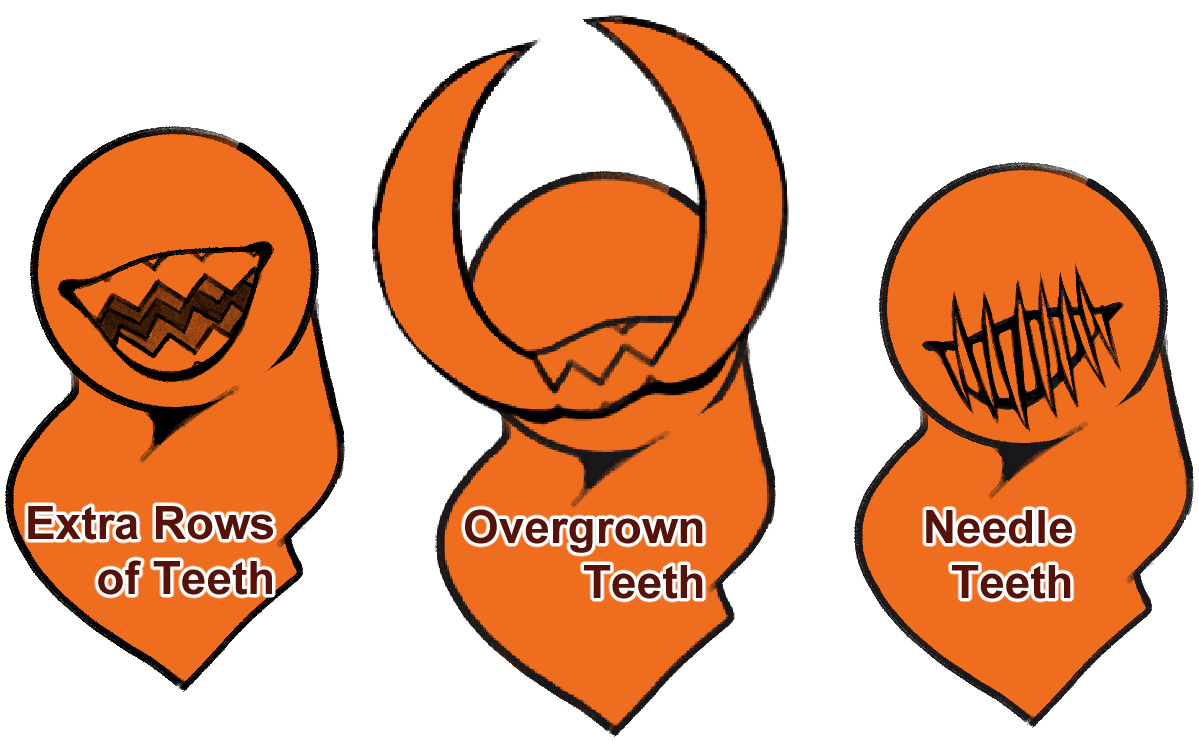
TOuched
- -
Unseen Affliction
- -
Lore-breaking
- Human Teeth - [This signifies that a CCCat took a human host. These beings are hunted by humans and are seen as truce-breakers]
- No Teeth
Tongue
A CCCat’s tongue must be above 43% saturation and value to be considered a living tongue. Please provide a flat and unshaded tongue reference when submitting a MYO or Redesign (MYO and Redesign Guide)
Required
- 1 Tongue
Common
- Patterned Tongue - [tongue has a visible marking or pattern on it. Pattern can be striped, spotted, or a variety/mixture of other patterns]
- Bumpy Tongue - [Small, bumpy textures on the tongue]
- Saturated/Living Tongue - [Tongue is bright and saturated, implying a living CCCat. Standard tongue cannot dip below 43% Saturation and Value on an HSV/B scale (MYO and Redesign Guide)]
Common Tongue Visual Examples
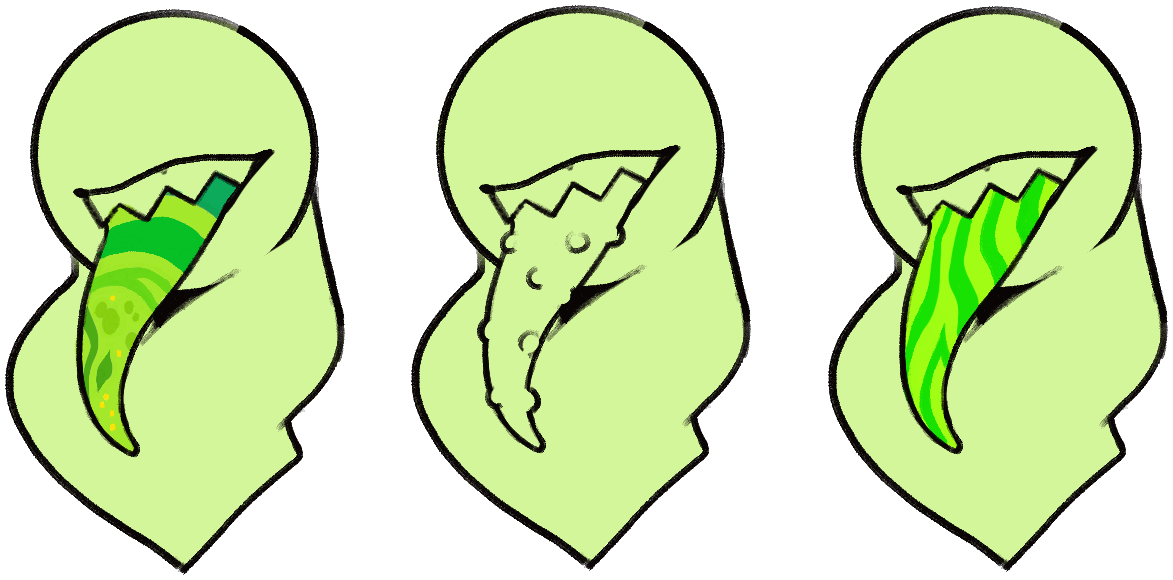
Uncommon
- Thin Tongue - [A Tongue that is thin in width, akin to a hummingbird]
- Thick Tongue - [A tongue that is wide and rounded]
- Forked Tongue - [A tongue with a small split at the end, like a snake]
- Spade Tongue - [A triangular or heart shaped end to the tongue. This cannot be complex like spaded tails]
UIncommon Tongue Visual Examples
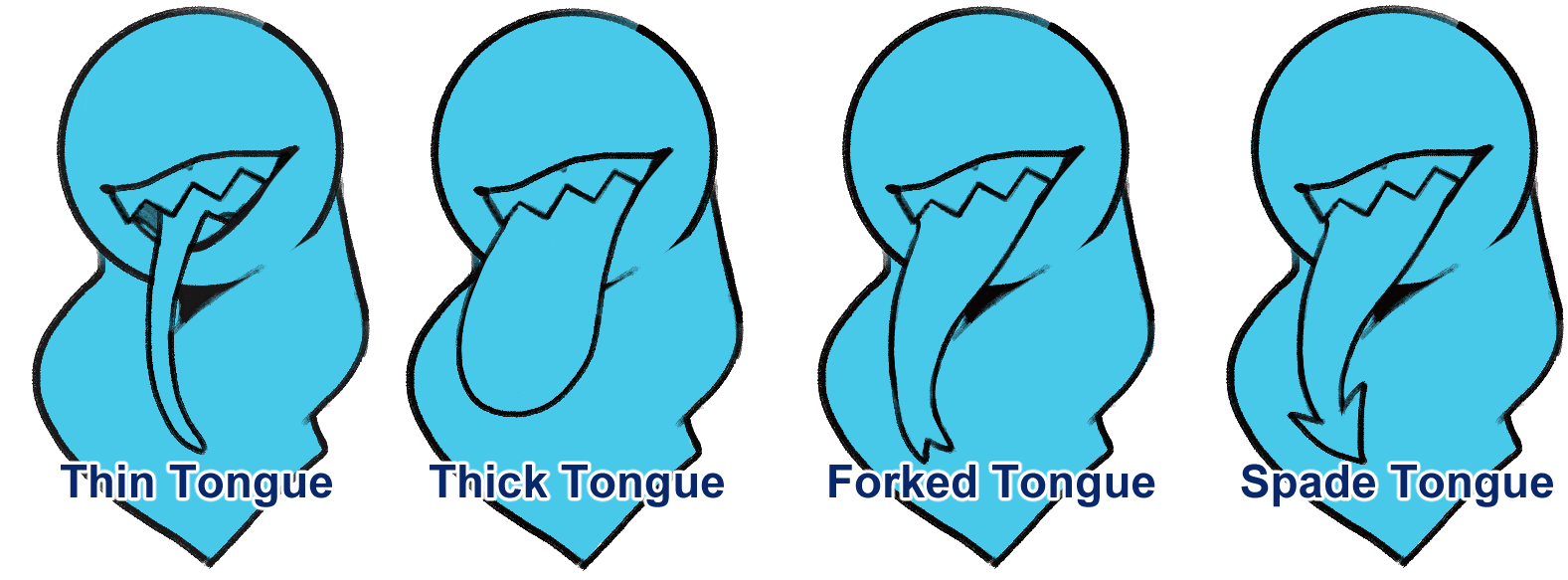
Rare
- Glowing Tongue Marking - [1 color on the tongue’s pattern glows. Glow must be the same color as the color beneath]
- Metallic Tongue Marking - [1 color on the tongue’s pattern is metallic]
- Opalescent Tongue Marking - [1 color on the tongue’s pattern is opalescent]
- Sparkling Tongue Marking - [1 color on the tongue’s pattern sparkles. Sparkles should not fall off the tongue]
- Ruffled Tongue - [A tongue standard in width, that has a flat frilling running down the sides or center]
- Spiked Tongue - [A tongue with small spikes]
- Hydra Tongue - [A tongue with multiple splits at the tongue tip, ranging from 3-4 splits]
- Patternless Tongue - [The tongue has no pattern]
- Twin Tongue - [The tongue splits up to halfway]
- Flat Tongue - [A Tongue that is flat in shape. The tongue should not be square, and still follow the standard tapered shape]
- Multi-Form Tongue - [The tongue changes between each new form of the CCCat. Any new tongue traits added must be counted additionally, but the eye can switch color and pattern between forms using this trait. Only applies if multiple forms are present on a design]
Rare Tongue Visual Examples
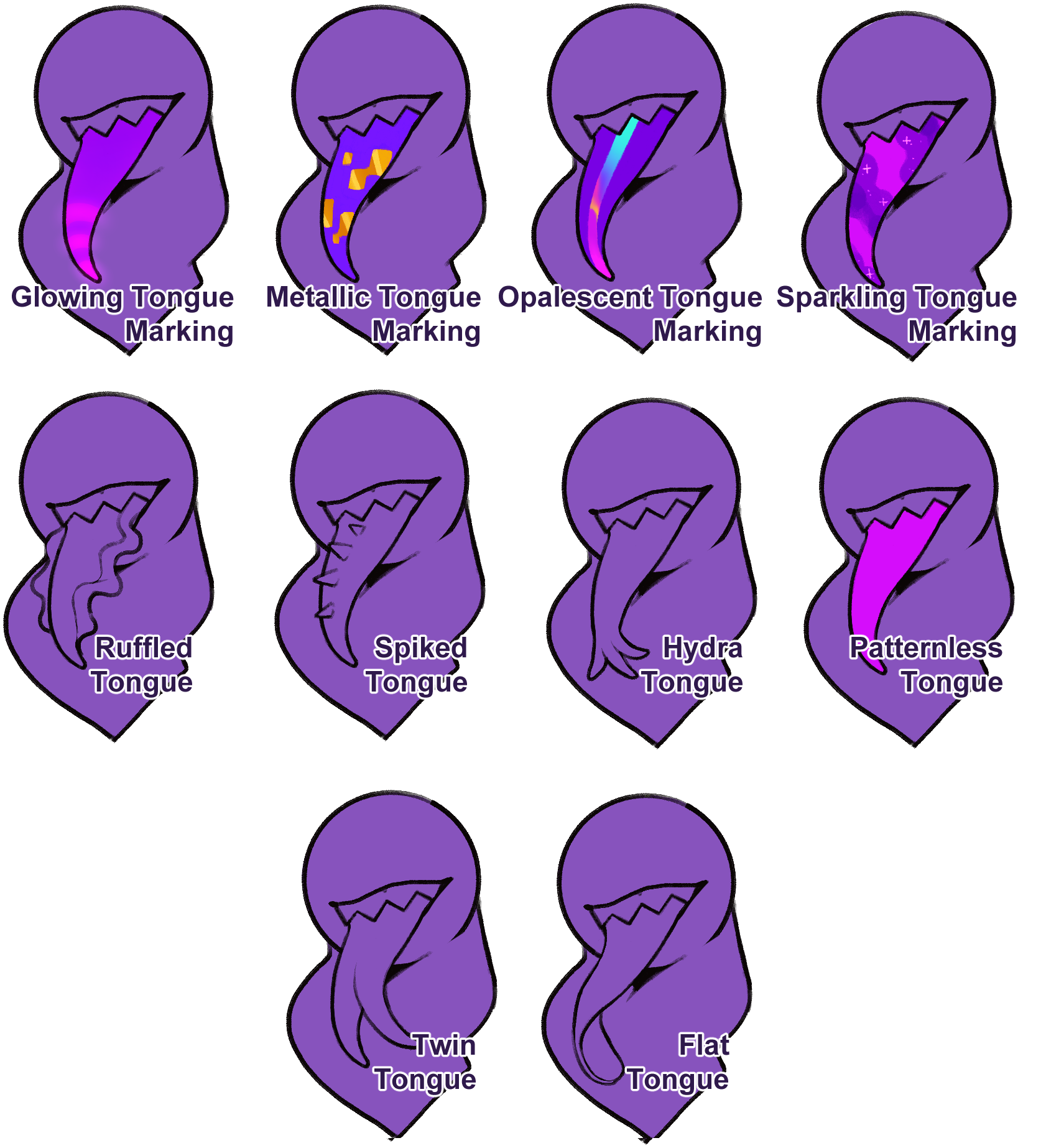
Myth
- Glowing Tongue - [Entire tongue glows. Glow must be the same color as the color beneath]
- Metallic Tongue - [Entire tongue is metallic]
- Opalescent Tongue - [Entire tongue is opalescent]
- Sparkling Tongue - [Entire tongue is sparkling. Sparkles should not fall off the tongue]
- Odd-Shaped Tongue - [Tongue is oddly shaped, such as unnatural tapers or naturally forming holes.]
- Overgrown Tongue - [Tongue that is very clearly larger than are proportional to the character]
Myth Tongue Visual Examples
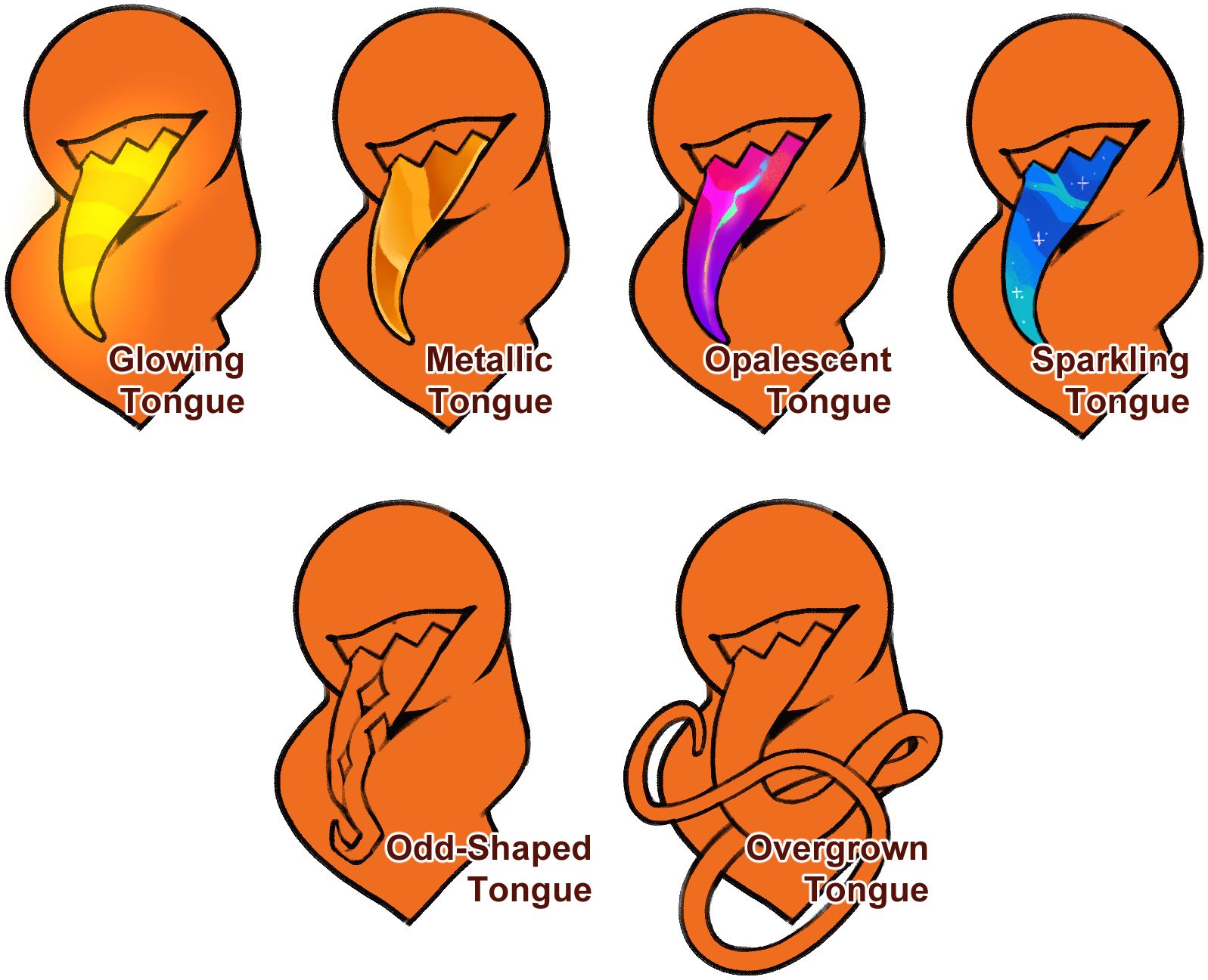
TOuched
- Dead Tongue - [Implies reanimation of a CCCat, and is shown through black, white, greyscale, or dull colors on the tongue. Any tongue with a Saturation or Value below 43% will be considered dead]
- Multiple Tongues (2-3) - [A CCCat who has up to 2 additional tongues apart from their standard tongue (3 total tongues)Up to 3 tongues can be affected by a shared tongue trait but do not need to visually look the same between one another]
- Elemental Tongue - [A tongue with features that are elemental or is made entirely of elemental substances]
- Transparent Tongue - [Tongue has some blurry transparency]
- Object Growth on Tongue - [Growths are present on the tongue, not replacing it]
- Object Tongue - [The tongue is replaced by an object of some kind, but retains its tongue shape]
Touched Tongue Visual Examples

Unseen Affliction
- Multiple Tongues (4-10) - [A CCCat who has up to 9 additional tongues apart from their standard tongue (10 total tongues) .Up to 3 tongues can be affected by a shared tongue trait but do not need to visually look the same between one another. Each additional tongue counts as a separate, unique tongue and does not share traits between them]
- Hand Tongue - [The tongue ends in a prehensile hand]
- Living Tongue - [The tongue resembles a creature or has a mouth on the end]
Unseen Tongue Visual Examples
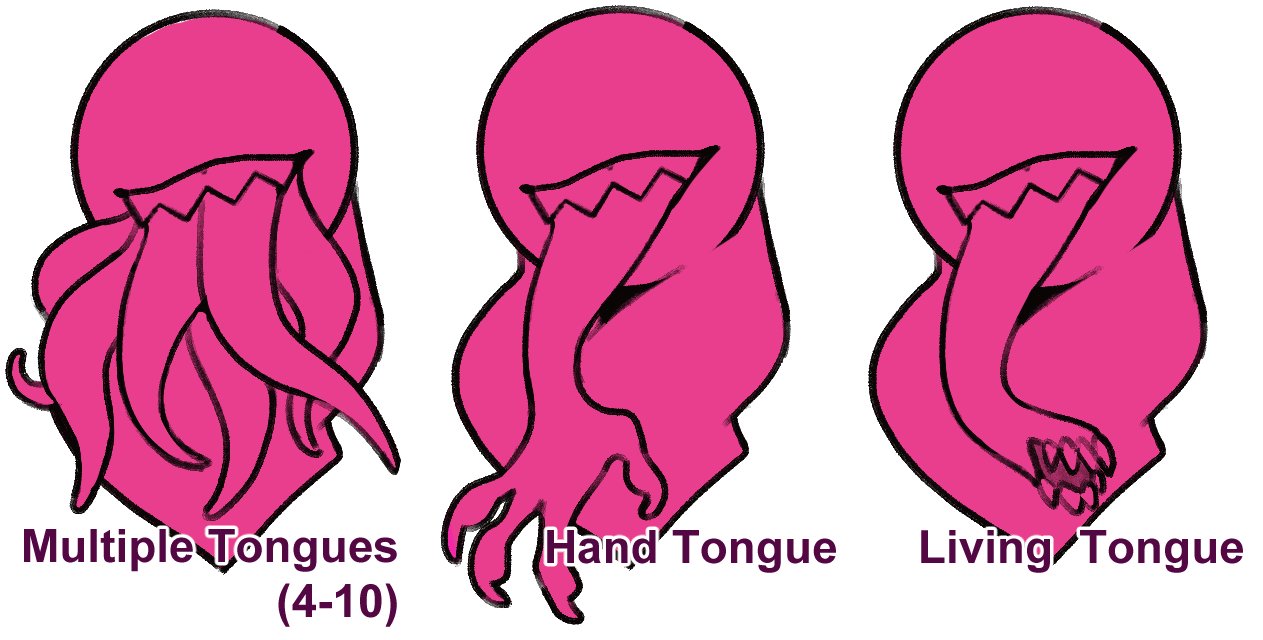
Lore-breaking
- Dead Tongue (Old-Gen) - [Tongue created with dead colors unintentionally or before rules were in place. The lore surrounding dead tongues can be used for these CCCats. Cannot be swapped for other traits. Please refer to the old-gen rules regarding this trait
- No Tongue
Required
- 1 Crownspike Minimum
Common
- Crowns on Back of Head - [Crowns are situated behind the ears and on the back of the head]
- 3-4 Crownspikes
- Mid-Length Crown
- Differing Crowns - [Crowns with different styles, shapes, or colors per spike]
- Emotive Crowns - [Crowns can emote and move to convey a CCCat's emotions]
Common Crown Visual Example
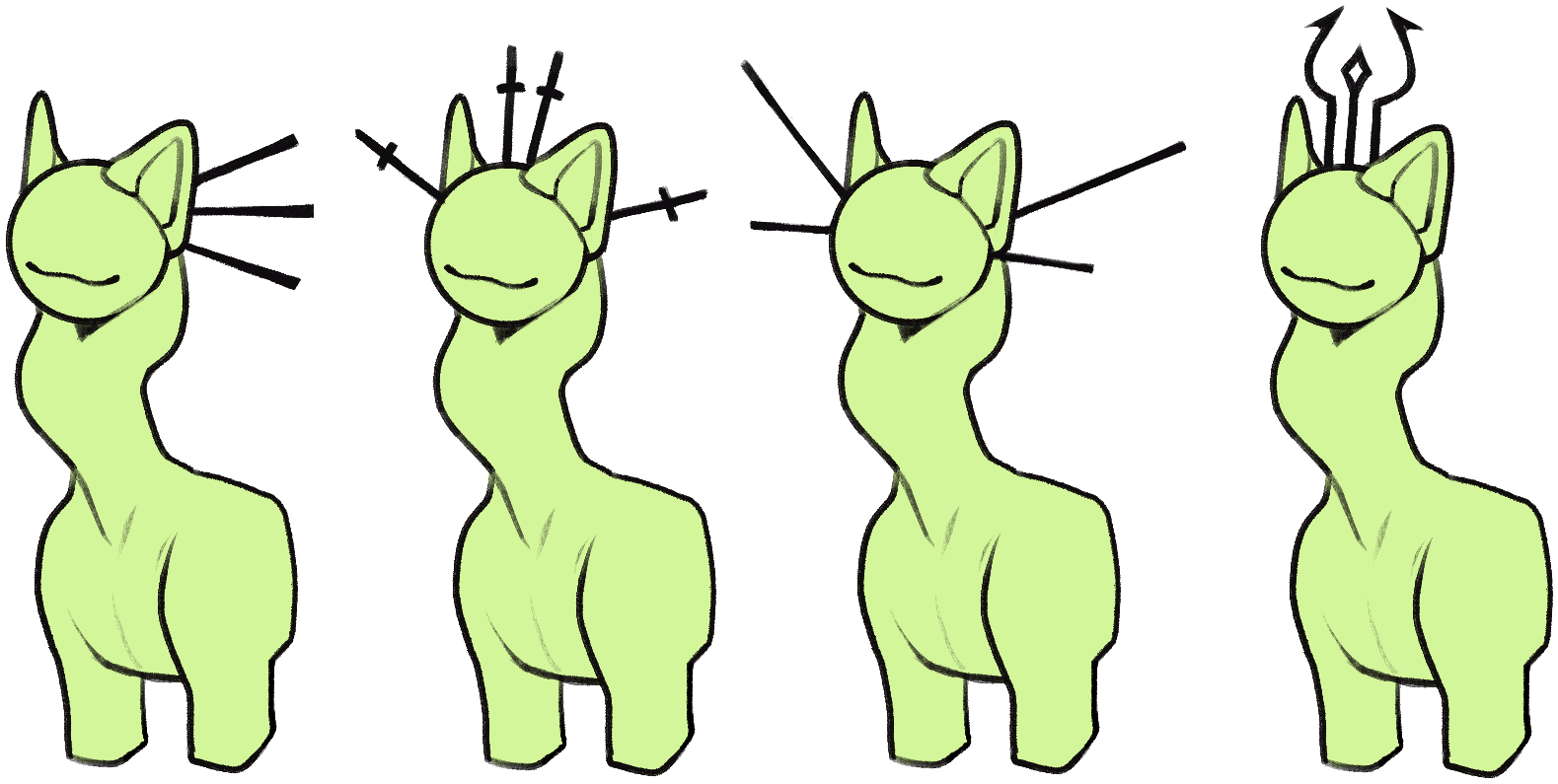
Uncommon
- 5-7 Crownspikes
- Particle Crown - [Non-elemental and glitter-like effects fall or hover around the crown. Can fade away as well as have small, simple shapes]
- Dangling Crownspikes - [Crowns that act like string and hang rather than stand upright]
- Short Crown - [An abnormally short crownspike, usually less than the length of the head]
- Thick Crown - [Crown is thick at the base]
- Crowns on Forehead - [Crowns are situated on the forehead, in front of the ears]
Uncommon Crown Visual Example
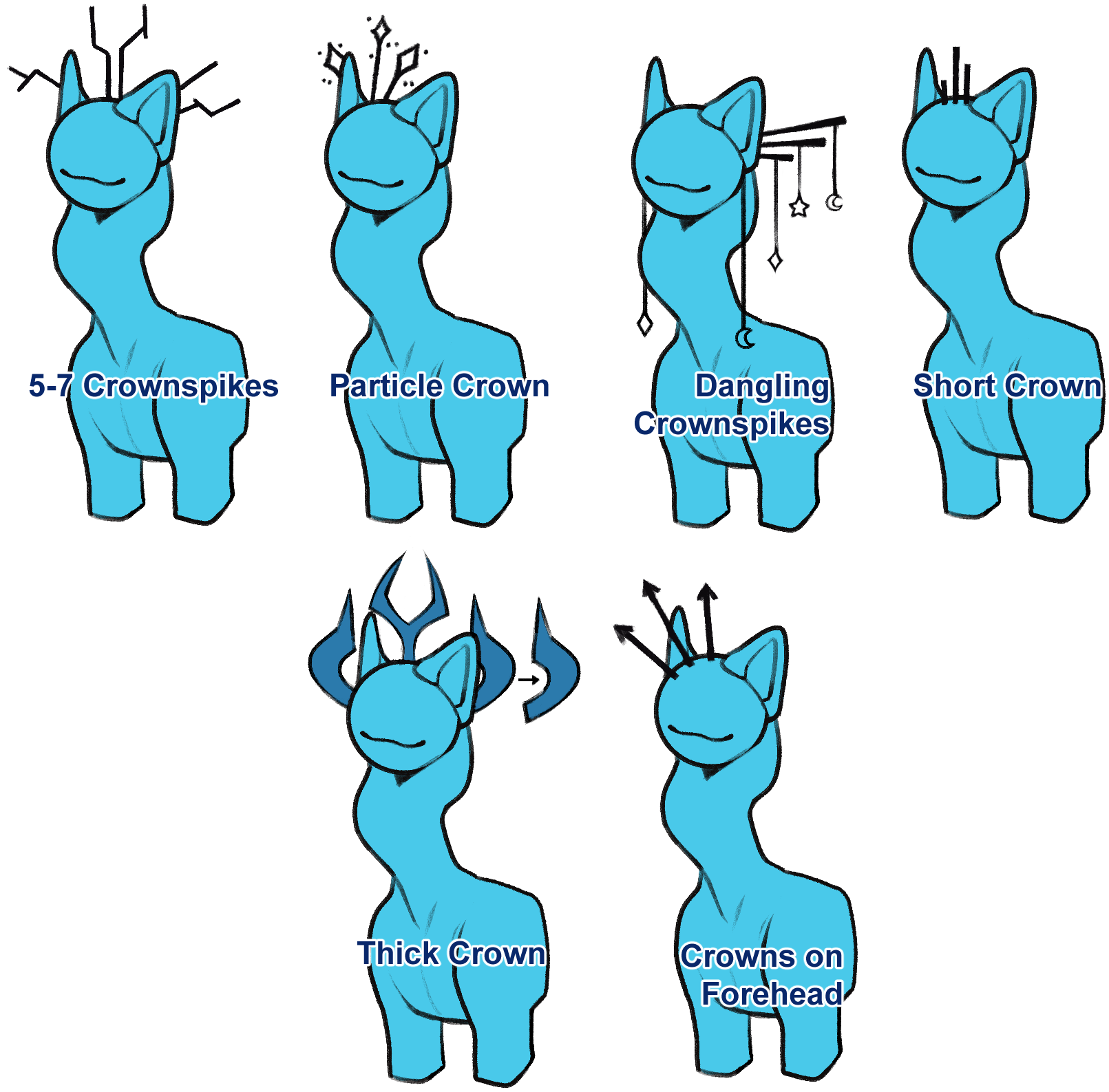
Rare
- 8-9 Crownspikes
- Crowns on Face/Cheeks - [Crowns on the front of the face and cheeks]
- Linked Crown - [Crownspikes that connect above the base]
- Floating Crown Piece - [Crown Base is connected, but part of the crown floats]
Rare Crown Visual Example

Myth
- 1-2 Crownspikes
- 10-20 Crownspikes
- Crowns on Lower Body - [Crowns are located somewhere other than the head. This includes traits like crowns on ears, spikes, etc]
- Overgrown Crowns - [Crownspikes that are very clearly larger than are proportional to the character]
Myth Crown Visual Example
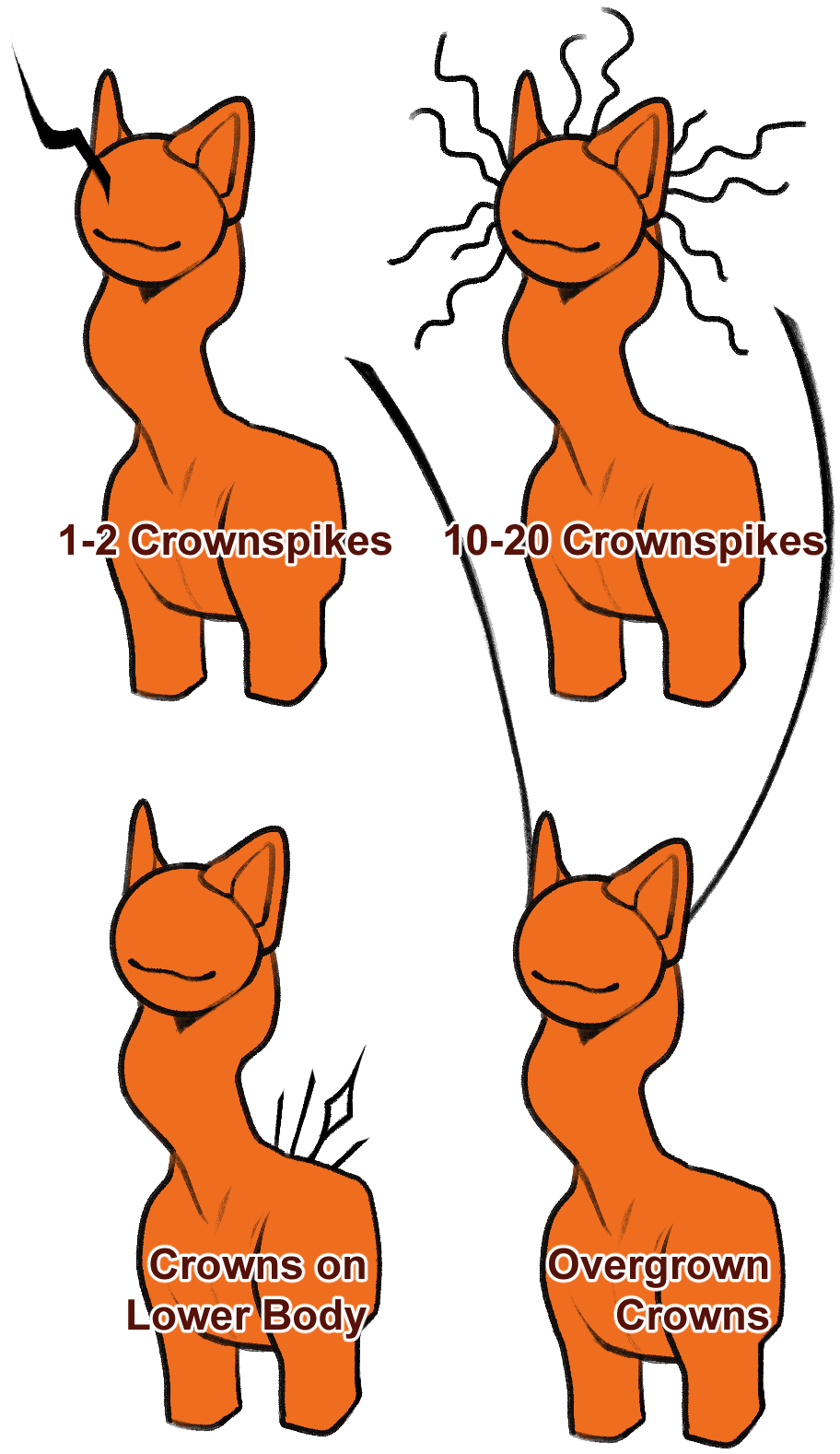
TOuched
- 21 - 30 Crownspikes
- Floating Crown - [Base of the crown is not connected, but rather floats over the CCCat. It must have some sort of crown spike on them to indicate that they are crowns]
- Crowns on Head and Elsewhere on Body - [Crownspikes are present on both the head and elsewhere on the body]
- Elemental Crown - [A crown with features or made up of elemental substances]
Touched Crown Visual Example

Unseen Affliction
- -
Lore-breaking
- No Crown
Required
- There are no tail requirements
Common
- Long Tail
- Fur-Tipped Tail
- Kinked Tail - [An odd bend in the tail]
- Thick Tail - [Includes gecko tails]
- Fluffy Tail
Common Tail Visual Examples

Uncommon
- Split Tail (1) - [The tail is split once above the halfway mark]
- Shaped Tail Tip - [The tip of the tail can take simple, flat forms such as a heart, star, circle, or club]
- Spaded Tail - [The tail ends in a small heart or triangle shape]
- Short Tail
Uncommon Tail Visual Examples

Rare
- Split Tail (2-5) - [Tail splits to no more than half its length. This can be used to create a branching effect up to 5 times (this number is counted by the number of times the tail splits, not the number of tail tips), but these must not be longer than half the tail length. Branches account for the total number of branches across all tails]
- Twin Tail - [A tail that splits past half its length, but not at the base. Can be applied to any number of tails]
- No Tail - [No tail is present]
- Object Tail Tip - [A tail that ends with an object of some kind]
- Flat Tail - [Tail is flat. It may have cutouts and shapes along its length, but tail must end in a flat or pointed shape unless other traits are present]
- Hooked Tail - [A hook shaped end to the tail. Can be odd in shape but must appear hook-like in shape]
Rare Tail Visual Examples
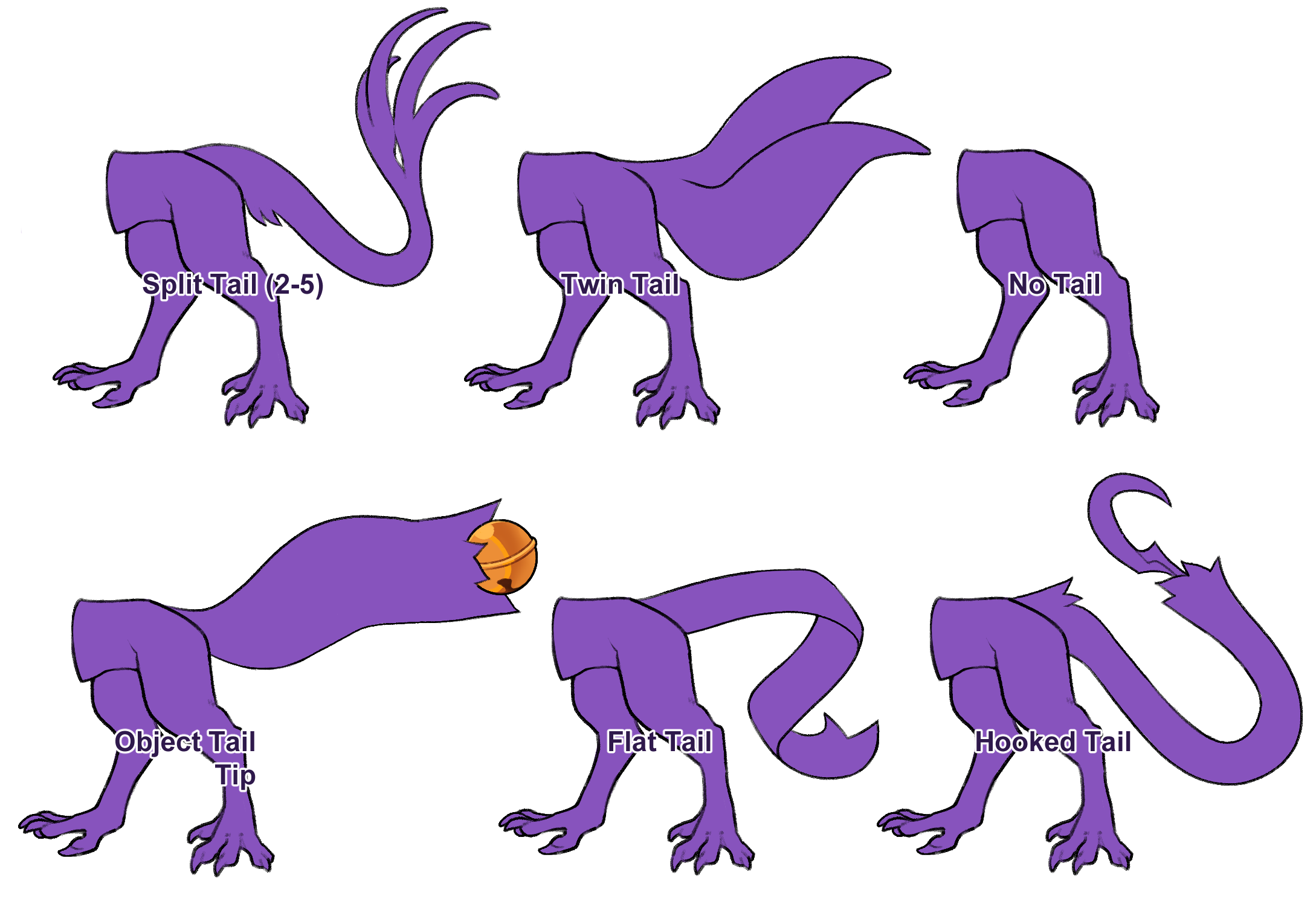
Myth
- Multiple Tails (2-10)
- Split Tail (6-10) - [Tail splits to no more than half its length. This can be used to create a branching effect up to 10 times (this number is counted by the number of times the tail splits, not the number of tail tips), but these must not be longer than half the tail length. Branches account for the total number of branches across all tails]
- Hand Tail - [Tail ends in a hand. Hand must be similar in size to standard body hands]
- Overgrown (Tail) - [Tail that is very clearly larger than is proportional to the character]
- Aquatic Host (Tail) - [Tail that has aquatic features usually noted by a caudal fin. The trait naturally allows webbing and gills as a default option without additional usage.]
- Arthropod Host (Tail) - [Tail that has arthropod features usually noted by a chitin plating, antennae, etc. The trait naturally allows chitinous plating and small mouth/face mandibles without additional usage.]
Myth Tail Visual Examples
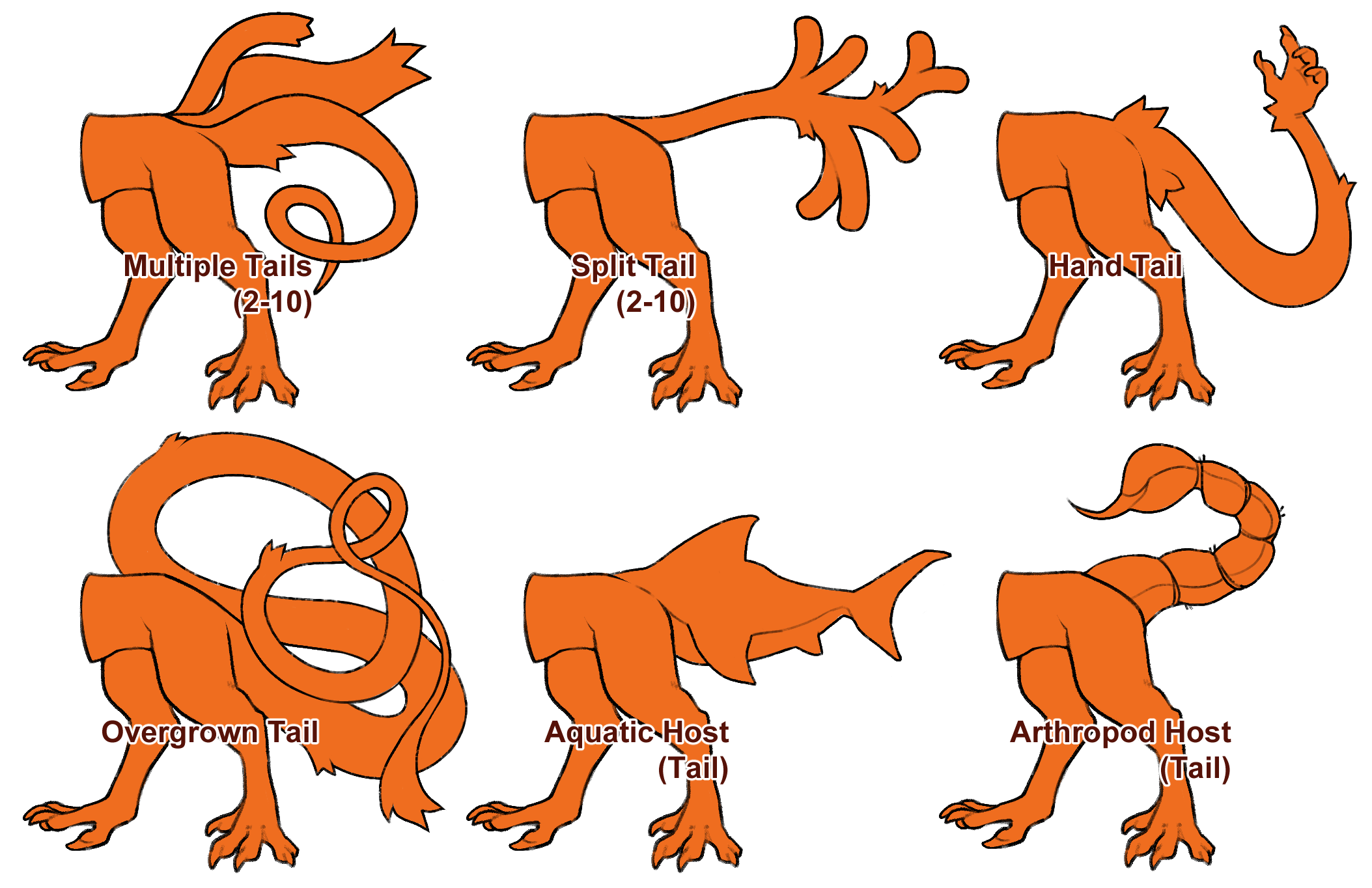
TOuched
- Multiple Tails (11-20)
- Split Tail (11-15) - [Tail splits to no more than half its length. This can be used to create a branching effect up to 15 times (this number is counted by the number of times the tail splits, not the number of tail tips), but these must not be longer than half the tail length. Branches account for the total number of branches across all tails]
Toggle Spoiler
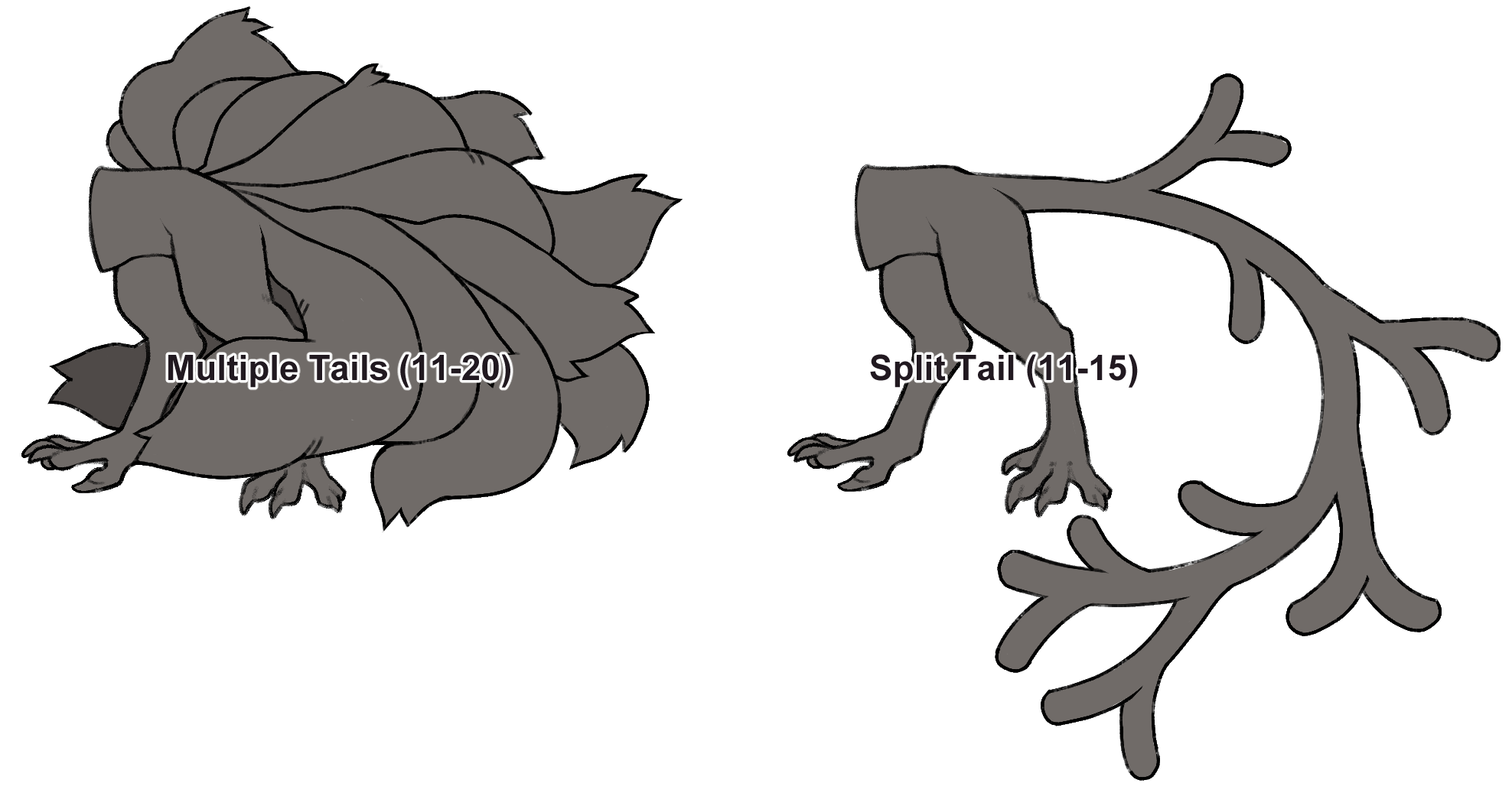
Unseen Affliction
- -
Lore-breaking
- -
Required
- 4 Limbs - [Any lost due to injury are not traited. Prosthetics should not appear fused with the body]
- 1 Head Minimum
- 3 Fingers and 1 Thumb - [Counts for front and back feet, though feet have slightly different anatomy than CCCat hands]
Common
- Body Type - [Bony, Thin, Athletic, Chubby, Fat, etc are all possible]
- Alternate Forms - [CCCats can canonically shift between a humanoid form, anthro form, sphinx form, centaur form, faun form, etc. These must resemble the official base form of the design, and should not have trait or design changes]
- Human Form - [CCCats can shift into a near-human form. The form has only one eye and it is also removable from the cranium via mouth. When the eye is in, the eye can move between both empty sockets as there is no brain. They must also keep their pointy teeth. Crowns are optional, as are other in-between forms]
Uncommon
- Floating Body Piece (1-5) - [Small, shaped object floating separately from the body. Must be extension from an existing part, that can include horns, tail tips, and more]
- Raptor Claw - [One very large hooked claw on both hands, both feet, or both hands and both feet]
- Spade Claws - [The claws have an extra spike facing backwards, appearing double ended]
- Pad Claws - [The claws extend further down to create hard finger pads]
- Snail Nails - [The claws have an internal curl present]
- Squiggle Lips - [Lips are permanently set in a zigzag/squiggle-like pattern]
- Lip Tags - [The lip has protruding shapes. These can be pointed, zipper shaped, or akin to eyelashes]
Uncommon Body Visual Examples
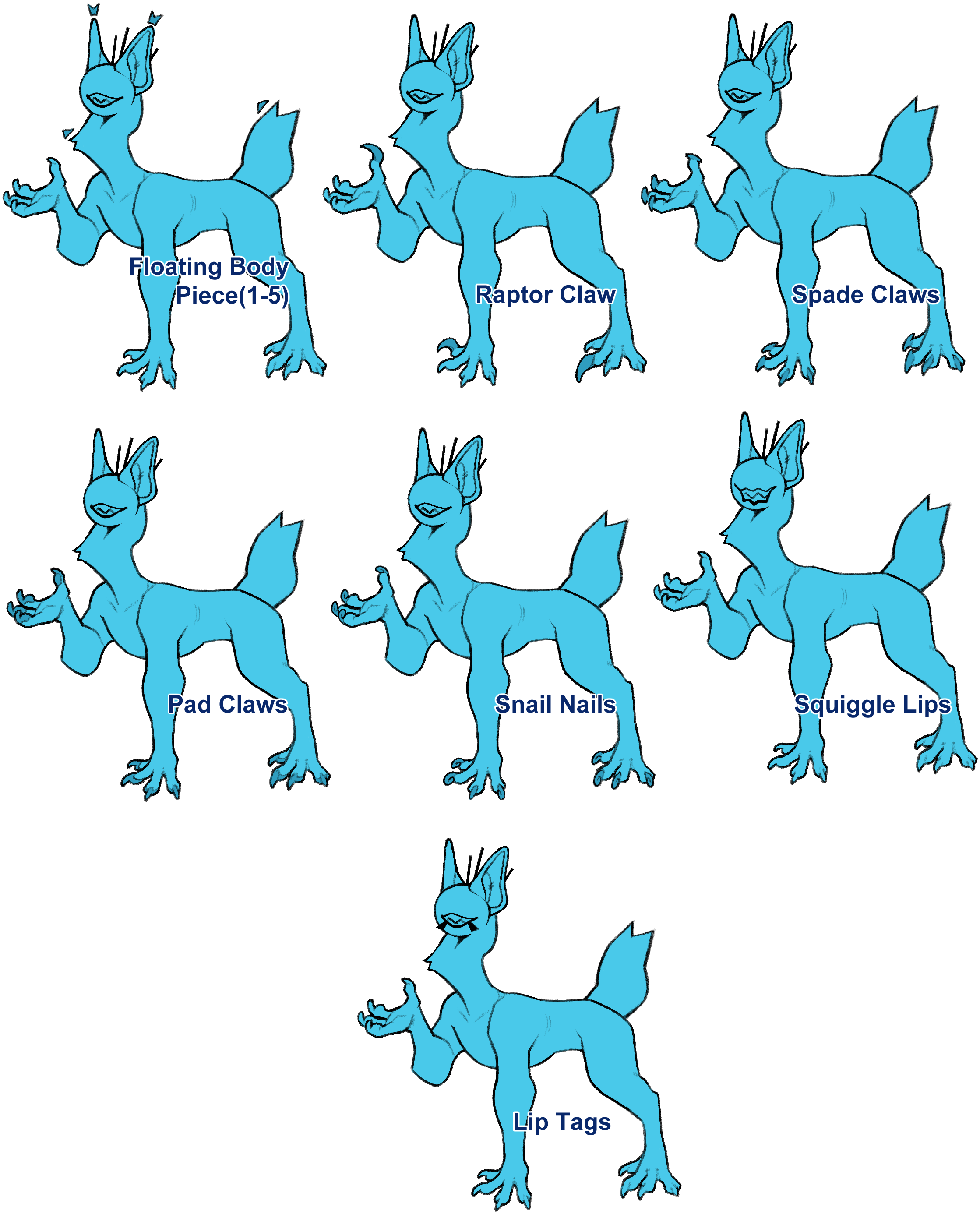
Rare
- Floating Body Piece (6-10) - [Small, shaped object floating separately from the body. Must be extension from an existing part, that can include horns, tail tips, and more]
- Horns/Spikes - [Anywhere on the body, any amount that does not obscure the body’s design. Includes antlers]
- Feather Growth - [Feathers growing anywhere on the body. Can cover the entire body]
- Scale Growth - [Scales growing anywhere on the body. Can cover the entire body
Rare Body Visual Examples
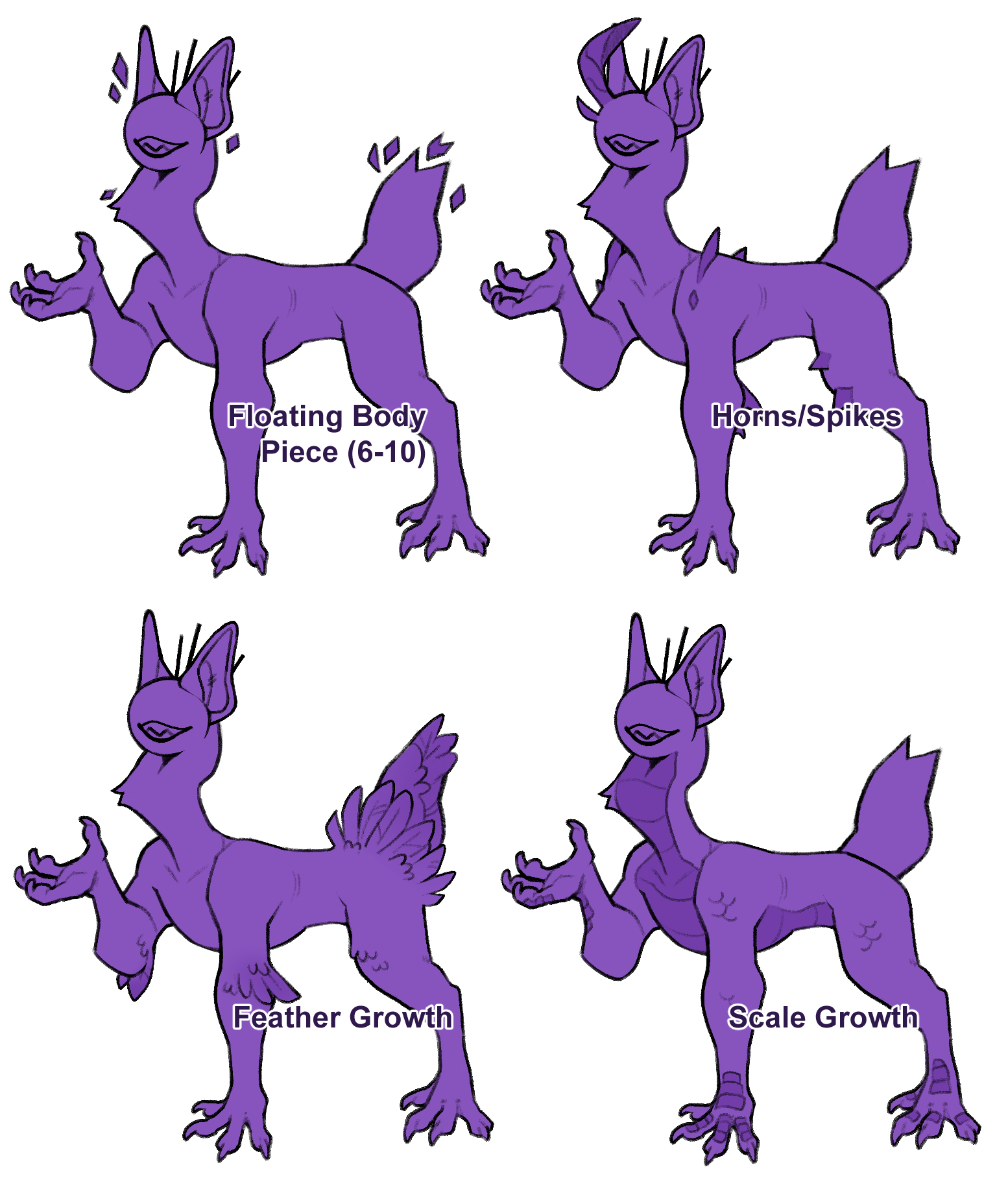
Myth
- Floating Body Piece (11-15) - [Small, shaped object floating separately from the body. Must be extension from an existing part, that can include horns, tail tips, and more]
- Aquatic Host - [Any part of the design resembling an aquatic creature counts as 1 myth trait, however the trait naturally allows webbing and gills as a default option without additional usage. Examples are fins, anglers, octopus tentacles, etc.]
- Arthropod Host - [Any part of the design resembling an insect, arthropod, or arachnid counts as 1 myth trait, however the trait naturally allows allows chitinous plating and small mouth/face mandibles without additional usage. Examples are segmented limbs, antennae, etc.]
- Paws - [Feet, Hands, or both are paws. Claws are retractable but must still exist]
- Hooves - [Feet, Hands, or both are hooves]
- Fused Mouth - [The mouth is connected by strips of skin]
- Vocal Sac - [The neck contains an inflatable sac that allows a croaking noise]
- Cobra Hood - [The neck can flare out like a cobra hood]
- Funky Feet - [Any difference in hand or feet shape, such as a dew claw or naturally missing fingers]
- Overgrown (Body) - [Body parts that are very clearly larger than are proportional to the character. This trait can work on a single group of body parts, such as arms, legs, hands, body, or neck. Specific aspects will be listed in the trait's notes on each individual design]
- Unusable Limbs - [Small additional limbs that have digits/joints that are unable to grab or grip objects. These can appear on their own anywhere on the body or attached to other limbs, with the hand/arm's anatomy noticeably changed]
- Object Growth - [The design grows some form of object across its body. This covers one type of item, even if that specific item (ie: wires) has more than one material. This can affect or replace the crown with the same object type]
Myth Body Visual Examples
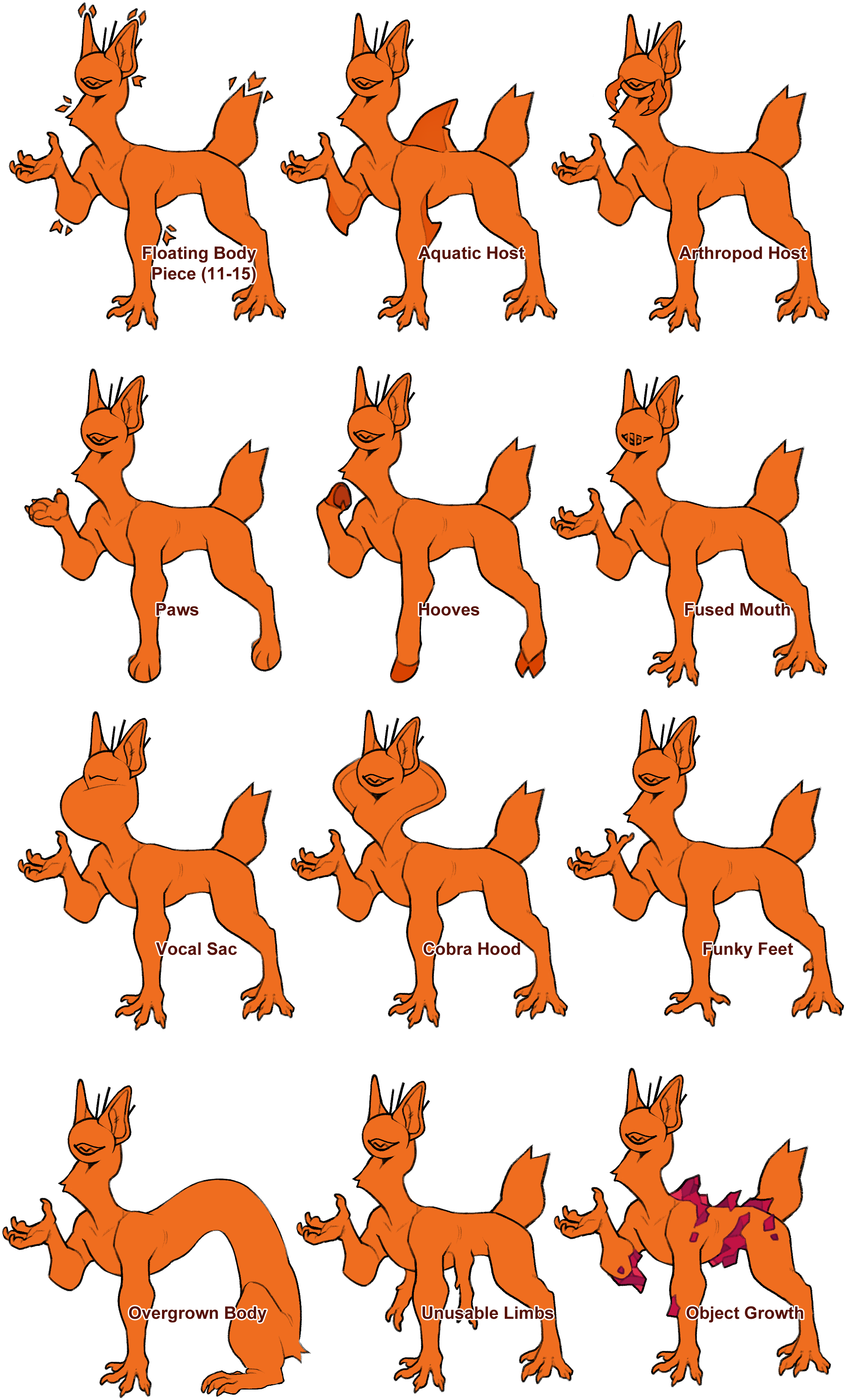
TOuched
- Multiple Forms - [The design has more than one form. Forms must be of the same base species as the rest of the forms. Each new form requires x1 extra of this trait]
- Floating Body Piece (16-20) - [Small, shaped object floating separately from the body. Must be extension from an existing part, that can include horns, tail tips, and more]
- Extra Mouths - [Any extra mouth above 3 total mouths (this includes the mouth on the face, meaning the body can have up to two more mouths) counts as an extra touched trait. The extra mouths can be anywhere else on the body as long as one remains on the face. Each mouth can have a tongue, but once the tongues differ from one another it is considered multiple tongues]
- Extra Head - [An extra head in a normal position or elsewhere such as the tail]
- Extra Limbs - [Any extra set of limbs above 3 sets total counts as an extra touched trait]
- Mouth Elsewhere On Body - [A mouth that is elsewhere from its proper place on the face]
- Repositioned Mouth - [The mouth is positioned non-standardly on the face, such as horizontal or diagonal]
- Separated Wormling - [The wormling exists outside of the host body]
- Altered Anatomy - [Anatomy is altered, such as adding an extra joint to a limb, or a wyvern like set of arms]
- Transparent Appendages - [Affects up to two appendages, i.e., head and tail per trait instance]
- Peg Legs - [Limbs do not end in a hand or foot, rather a peg]
- Wings - [Any Extra set above 2 total sets of wings counts as an extra touched trait]
- Beak
- Exposed Bone - [Due to injury, bone remains exposed]
- Inanimate Host - [CCCat takes a host that is inanimate or an object, and the body is influenced by this. This trait is displayed as part or all of the host being replaced with the specific object as part of its body]
- Crook Mutation -
[The CCCat develops multiple eyes fused to the body, mimicking a Crook's eye clusters. They will always have one larger main eye. They must also have crowns centered around this main eye.]
CCCats may also:
- Have dead eye colors that drop below the 43% Hue/Saturation requirement.
- Have an inner humanoid mouth akin to a Crook's. They do not gain two separate tongues.
- Have tendrils. Any tendril traits should be referred to under the Crook traits section. They can no longer have crowns centered around the eye if using tendrils.
- Have a face patch with exposed teeth.
- Have knuckle bones on the hands and feet.
Touched Body Visual Examples
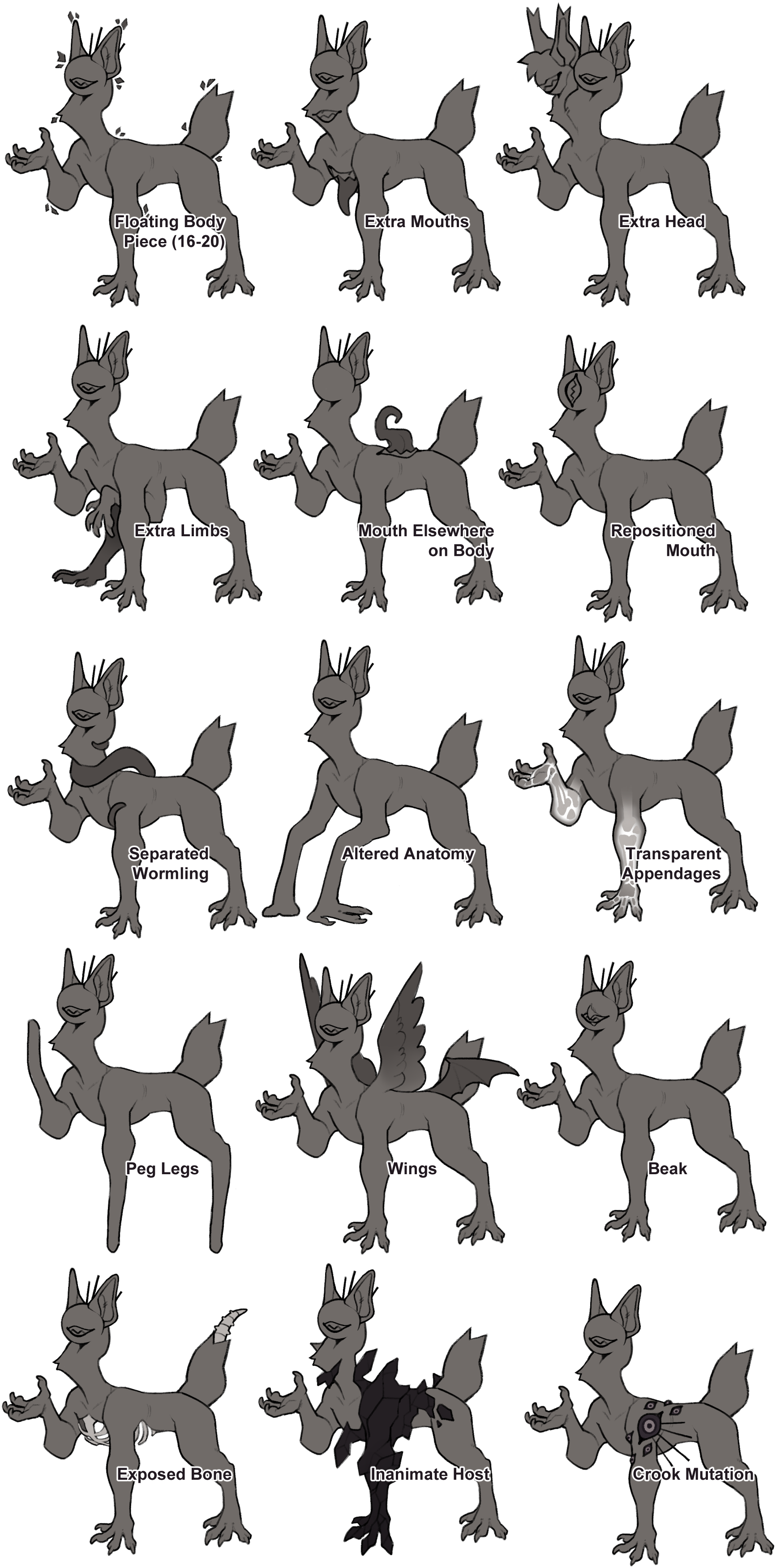
Unseen Affliction
- Overgrown Mouth - [The mouth is overgrown on the face or elsewhere, if paired with the Mouth Elsewhere on Body Trait. Often depicted as the mouth continuing off of the skull and down the neck, or overall larger than average]
- Limbless - [The design is naturally missing a set of limbs, such as arms or legs]
- Hallowed - [The body has grooves or holes naturally present]
- Lamprey Mouth - [Teeth are situated in a circle around the mouth. This includes multiple layers]
- Gulper Mouth - [The mouth extends beyond the bounds of the skull and can open very wide, akin to a gulper eel]
- Headless - [No head is present. A mouth must be present elsewhere on the body (it will naturally form on the neck if the head is missing), and crowns will form naturally on the neck]
- Wormling Body - [Part of the body is replaced by the wormling, such as the tail]
- Fullbody Transparency - [The whole body is able to be affected by transparency]
Unseen Body Visual Examples
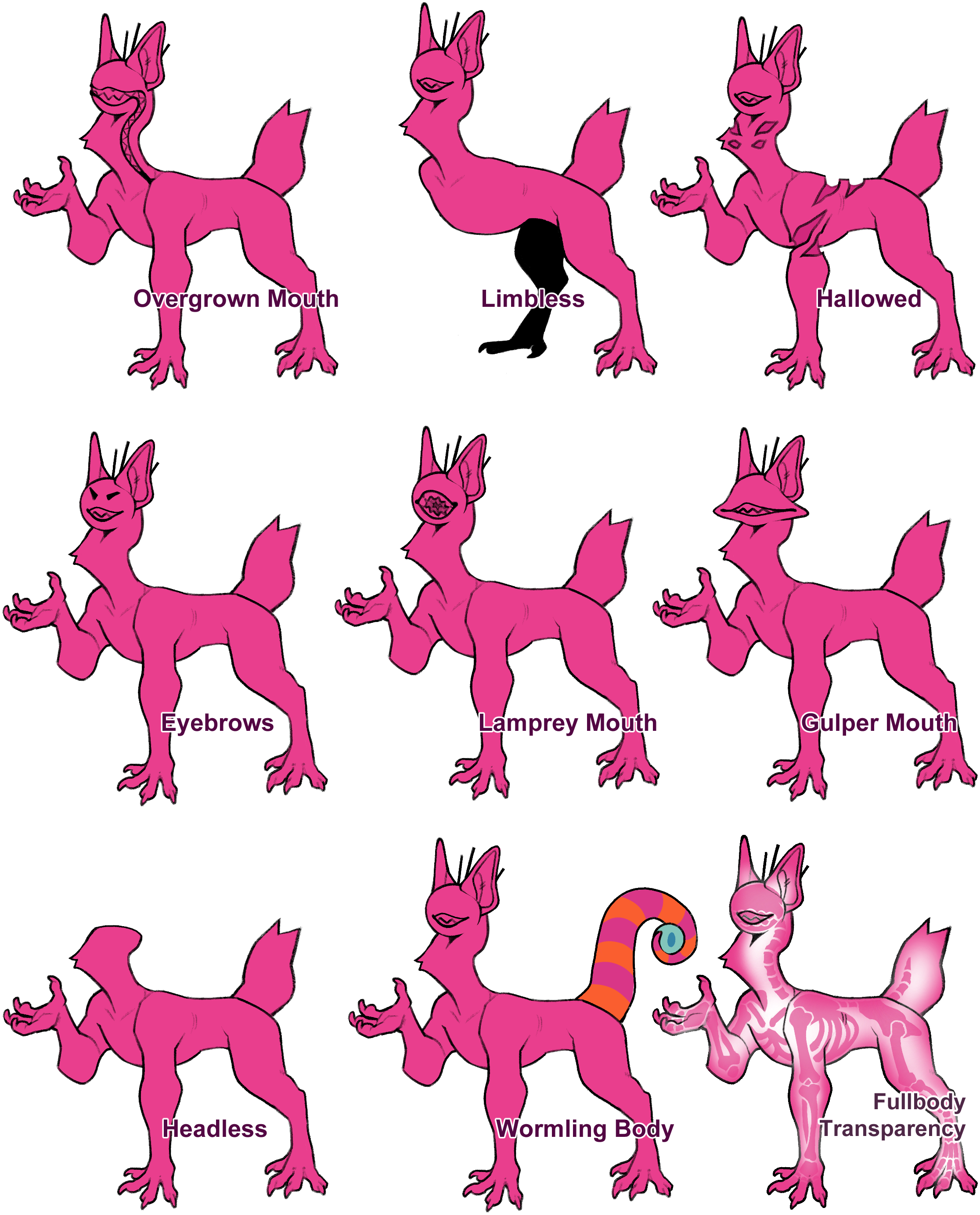
Lore-breaking
- Nose
Misc
Required
- -
Common
- -
Uncommon
- -
Rare
- -
Myth
- Chibi Size - [Available to CCCats that possess a myth trait or higher. Does not count as an extra trait. Min 3’0”]
- Monster Size - [Available to CCCats that possess a myth trait or higher. Does not count as an extra trait. Max 9’0”]
TOuched
- Extra Tiny - [The CCCat is smaller than Chibi. It cannot be so miniscule that it is invisible. This does not count as an extra trait, and is available to CCCats that possess a Touched trait. Min 2’0”]
- Extremely Large - [The CCCat is larger than Monster size. It cannot be impossibly large. This does not count as an extra trait, and is available to CCCats that possess a Touched trait. Max 10’0”]
Unseen Affliction
- -
Splice
- Splice - [A fusion of a CCCat and another Skire species, resulting in the CCCat displaying traits of this species. Crook Mutation is the equivalent of a splice with a Crook]
Art - Sweet-n-treat